Ritron RIT37-446D UHF-FM Desk Top Transceiver User Manual TYPE OF EXHIBIT
Ritron Inc UHF-FM Desk Top Transceiver TYPE OF EXHIBIT
Ritron >
USER MANUAL
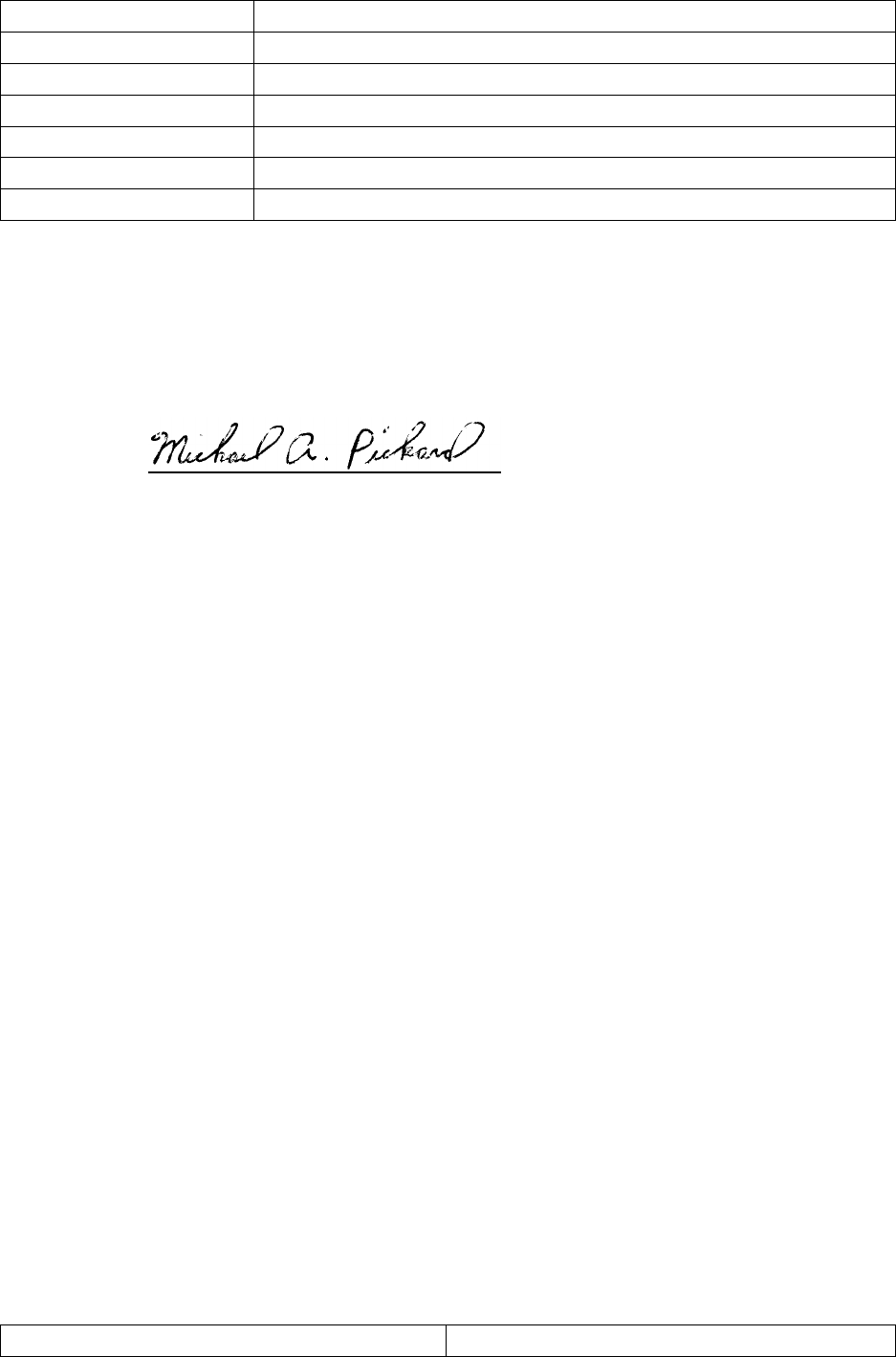
Page 1
JBS-446D_UserMan.pdf
TYPE OF EXHIBIT:
INSTALLATION AND OPERATING INSTRUCTION MANUAL
FCC PART:
2.1033 (c)(3)
MANUFACTURER:
RITRON, INC.
MODELS:
JBS-446D
TYPE OF UNIT:
UHF-FM 2-Way Desk Top Radio
FCC ID:
AIERIT37-446D
DATE:
October 6, 2014
Included in this exhibit is a draft copy of the User Manual for RITRON Model JBS-446D UHF-FM 2-Way
Desk Top Radio.
This manual provides the end user with installation and operating instructions.
SIGNED:
Michael A. Pickard - Project Engineer

Have questions? Call 800-USA-1-USA (800-872-1872) or visit our website at www.ritron.com page 1
Display-Series Two-Way Base Station
Owner’s Manual
RUGGED, PROFESSIONAL TWO-WAY BASE RADIOS
ALWAYS THERE…ALWAYS READY…ALWAYS ON
SM
114 UHF and 27 VHF Table Frequencies for Easy Field Programming
Built-in Quiet Call ® and Digital Quiet Call ® Interference Eliminator
Up to 10 Channel Capability
12 VDC or Wall Outlet 120 VAC Operation
NOAA Weather Channel Feature (VHF only)
Emergency Weather Alert Feature (VHF only)
Easy-to-Hear High Audio Output
Call Tone
“Z” Button - Programmable Soft Key
2-Tone Encode / Decode
DTMF ANl Encoding
Channel Scan
2 Watts of Power
2013 FCC Narrowband Compliant
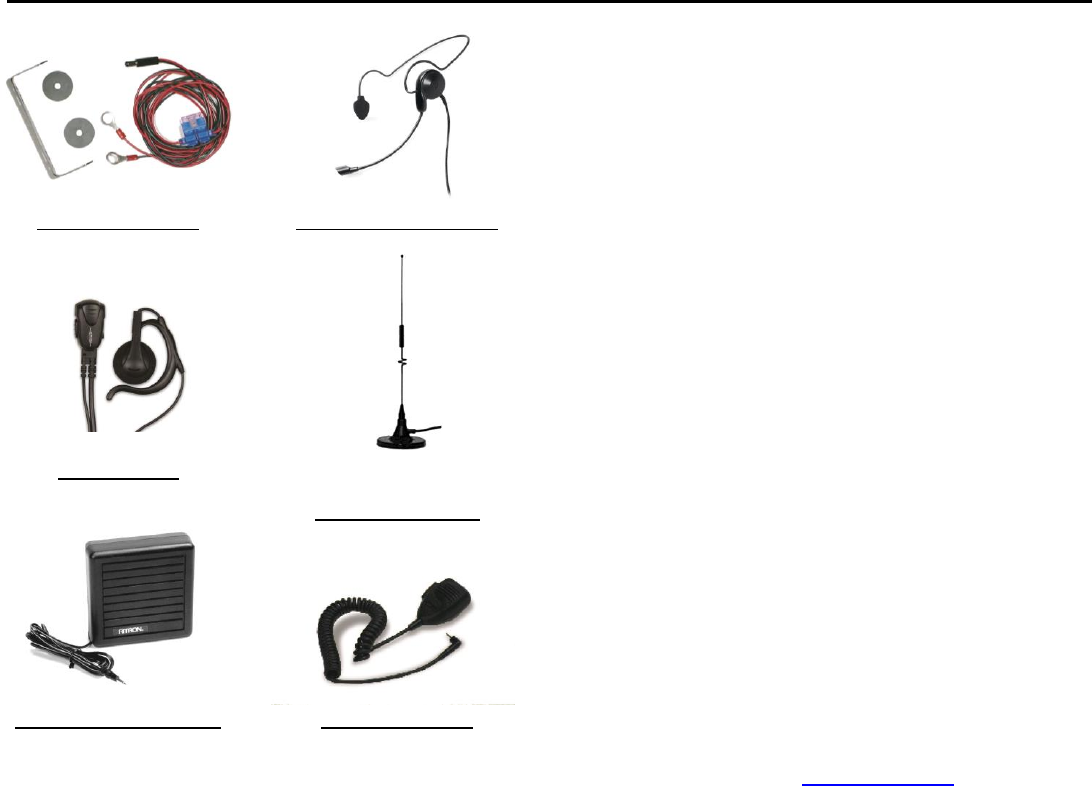
ACCESSORIES
Have questions? Call 800-USA-1-USA (800-872-1872) or visit our website at www.ritron.com page ii
JBSK-12 RHD-6X
12-Volt Adapter Kit Behind the Ear Headset
RHD-8X
Single Earbud Ram-1545
Magnet-mounted
Dual-band Antenna
RSP-5 RM-7
5-Watt External Speaker Hand Microphone
OPTIONAL REPLACEMENT ACCESSORIES:
TO ORDER CALL 800-USA-I-USA
AFB-1545 .... Molded Flex, Dual-band Replacement Antenna
RAM-I545..... Magnet-mounted, Dual-band Antenna w / BNC
RPS-IB ......... Replacement 110 VAC Power Supply
CCL-M ......... 12 VDC, Cigarette Lighter Adaptor
JBSK-I2 ....... 12 VDC, Adaptor Kit
REP-2 .......... Low Profile Earphone
RHD-IX......... Single Ear Headset
RHD-4X........ Dual Ear Headset
RHD-6X........ Lightweight Behind-the-head Earset w / In-line PTT
RHD-8X........ Lightweight Earbud w / mic and In-line PTT
RSM-3XA ..... Remote Speaker Microphone
RM-7 ............ Hand Microphone & Hang-up Bracket
RSP-5 .......... External Speaker w / 5 Watt Audio Capability
JBS-MMK .... Mobile Mounting Kit
(Does not include screws to mount bracket to wall or vehicle)
Call RITRON for a complete listing.

TABLE OF CONTENT
Have questions? Call 800-USA-1-USA (800-872-1872) or visit our website at www.ritron.com page iii
DESCRIPTION PAGE
ACCESSORIES
Optional Accessories ............................................ii
INTRODUCTION
“Display Series” Model Numbers .......................... 1
Basic Features ..................................................... 1
2013 FCC Narrowband Mandate .......................... 2
CONTROL & OPERATION .................................. 3
FIG-1: Radio Controls and Connectors ................. 3
OPERATION
FIG-2: Volume Level Indicator .............................. 4
ON-OFF / Volume Adjust ..................................... 4
Channel Selection ................................................ 4
Receive ............................................................... 4
QC and DQC Tone Codes
(Interference Eliminator Codes) ............................ 5
Squelch Modes .................................................... 5
Transmit .............................................................. 5
FIG-3: Transmit Busy Lamp ................................. 5
Radio Alert Tones ................................................ 6
Optional Alert Tones ............................................ 6
Channel Scan Operation ...................................... 7
2-Tone Decode Operation .................................... 8
FIG-4: 2-Tone Call Alert ....................................... 8
“Z” Button - Programmable Soft Key .................... 9
NOAA WEATHER RADIO FEATURE
How to Select Your Local NOAA Weather
Frequency ......................................................... 10
NOAA Weather Feature ..................................... 10
FIG-5: Selecting Your Local NOAA Weather
Frequency ......................................................... 11
DESCRIPTION PAGE
FIG-6: NOAA Frequencies ................................. 11
NOAA Weather Alert Feature ............................ 11
Using the “Z” Button to Access NOAA Weather .. 11
RADIO PROGRAMMING
FIG-7: How to Place the Radio in Program /
Readout Mode ................................................... 12
How to Readout Field Programmed
Frequency & Tone Codes ................................... 12
How to Field Program Frequency and
Tone Codes ....................................................... 13
Table 1: Programmable Frequency Codes.......... 14
Table 2: Programmable QC Tone Codes ............ 15
Table 3: Programmable DQC Codes .................. 15
How to Field Program Radio Feature Codes ....... 15
Table 4: Radio Feature Codes ............................ 15
How to Delete a Channel .................................... 16
PC Programmable Features ............................... 16
!! CAUTIONS —ALL RADIOS!!
Observe Caution in the Following Environments
to Maximize the Life of Your Radio Equipment .... 17
Exposure to Radio Frequency Energy ................ 17
TROUBLESHOOTING ....................................... 18
SPECIAL APPLICATION
How to Field Program 2-Tone Encode Codes ..... 19
for GateGuard Applications, go to
www.ritron.com/pdf/gg_07.pdf
How to Send a 2-Tone Code .............................. 19
TABLE 5: Programmable 2-Tone Encode Code .. 19
DESCRIPTION PAGE
FCC & IC LICENSE REQUIRED
Licensing ............................................................20
Safety Standards ................................................20
How to Obtain an FCC Radio License .................20
Industry Canada Regulations ..............................20
Service ...............................................................20
LIMITED WARRANTY ......................................21
ADDENDUM TO MANUAL
JBS-146i-A and JBS-446D-A Instructions
Auto Turn On When Power Restored ..................22
FIGURES:
1. Radio Controls and Connectors ..................... 3
2. Volume Level indicator .................................. 4
3. Transmit / Busy Lamp ................................... 5
4. 2-Tone Call Alert ........................................... 8
5. Selecting Your Local NOAA Weather
Frequency ....................................................11
6. NOAA Frequencies ......................................11
7. How to Place the Radio in Program /
Readout Mode ............................................ 12
INSPECTION
Make sure the package includes:
“Display Series” base radio
Antenna
RPS-1B Wall Mounted Power Supply
Examine the equipment immediately
after delivery and report any damage to
your shipping company.

INTRODUCTION
Have questions? Call 800-USA-1-USA (800-872-1872) or visit our website at www.ritron.com page 1
THANK YOU FOR CHOOSING RITRON
Congratulations on your purchase of the “Display Series” base
station. Your new radio is the result of Ritron’s more than 30
years history of designing, manufacturing, and supplying reliable,
professional wireless communication products. Ritron wireless
products will improve the operation, safety, and profitability of
any organization by providing instant voice communications
between employees throughout the workplace.
“DISPLAY SERIES” MODEL NUMBERS
VHF MODELS: JOBCOM & RITRON
JBS-146i (Jobcom) (2-W, 10 Ch)
JBS-146i-A (Jobcom) (2-W, 10 Ch)
JBS-146D-BC (Jobcom) (2-W, 10 Ch)
JBS-146D-CANADA (Jobcom) (2-W, 10 Ch)
PBS-I46D-BC (Ritron) (2-W, 10 Ch)
PBS-146D-CANADA (Ritron) (2-W, 10 Ch)
UHF MODELS: JOBCOM & RITRON
JBS-446D (Jobcom) (2-W, 10 Ch)
JBS-446D-A (Jobcom) (2-W, 10 Ch)
JBS-446D-CANADA (Jobcom) (2-W, 10 Ch)
PBS-446D (Ritron) (2-W, 10 Ch)
PBS-446D-CANADA (Ritron) (2-W, 10 Ch)
The model number located on the back of the radio case
indicates its operating band.
VHF radios are designed to operate on up to ten channels within
the 24 MHz band between factory standard 150 and 174 MHz.
UHF radios are designed to operate on up to ten channels within
the 20 MHz band between factory standard 450 and 470 MHz.
BASIC FEATURES
This manual covers Ritron JBS / PBS “Display Series” base
stations. A rugged, programmable two-way desktop base station
designed to operate in a professional FM communications band
(VHF or UHF business available). Each radio is equipped with
these features:
Push-button Operating Controls. The Push-To- Talk (PTT),
Channel, On / Volume Up, Volume Down / Off and the
special feature “Z” button controls are conveniently located
on the face of the radio.
Channel Display. The LED display will show the current
operating channel, and contains a transmit / busy lamp. The
display is also used to indicate volume level and paging decode
status on radios programmed for 2-Tone paging operation.
10-channel Capability. Up to 10 channels can be programmed
to contain a unique set of operating frequencies and options.
QC (Quiet Call) and DQC (Digital Quiet Call) Interference
Eliminator Codes. Each channel can be programmed from a
list of 50 QC sub-audible or 104 DQC digital privacy codes.
Field programming. The “Display Series” base radio allows
you to quickly select and program each channel individually
while in the field without the need for a PC programmer. Each
channel can be programmed to one of 27 VHF or 114 UHF
channel table frequencies and one of 50 QC or 104 DQC
interference eliminator codes, or you can delete a channel
altogether.
Channel Scanning. Channel Scan allows scanning of all
channels programmed into the radio, and can be turned On
and Off through Field programming. The scan channel has
many features, including Priority Scanning and Busy Channel
Blocking.
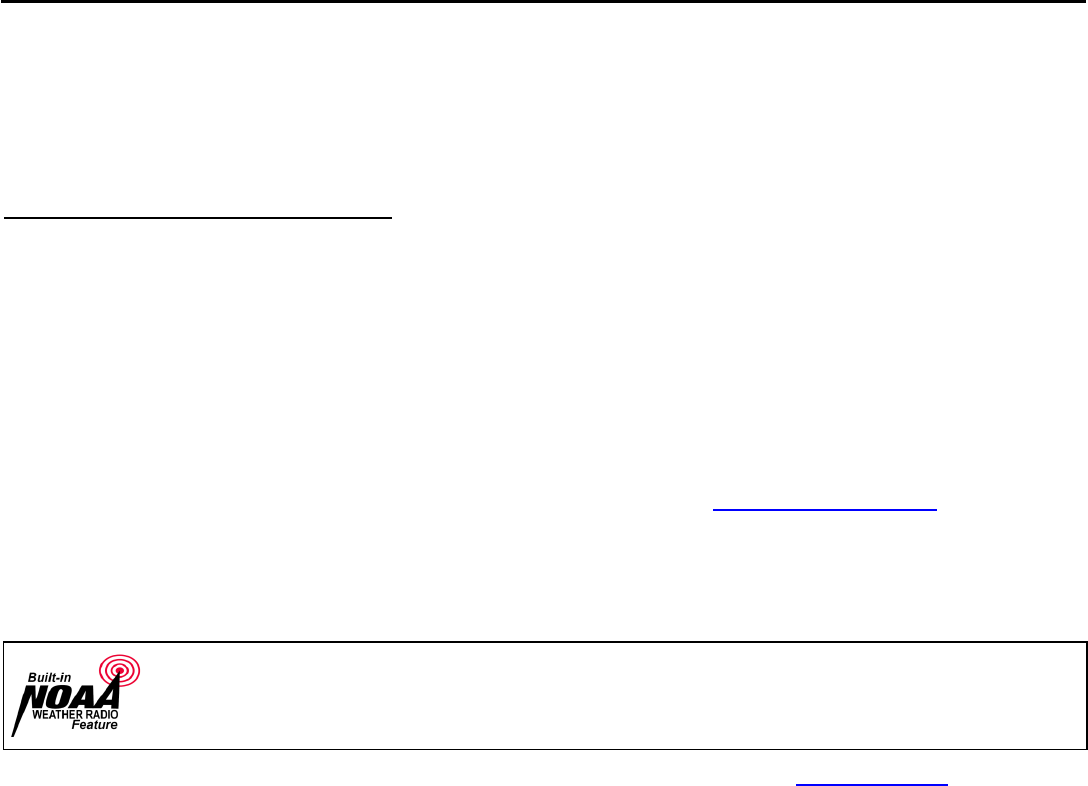
INTRODUCTION
Have questions? Call 800-USA-1-USA (800-872-1872) or visit our website at www.ritron.com page 2
Special Feature “Z” button. The “Z” button is capable of
performing one of a variety of functions. These functions can
be PC programmed by your dealer OR certain functions (in
bold) can also be assigned to the “Z” button by the end user.
“Z” button function options: Channel Scan, Weather
Channel, Monitor, Send 2-Tone Code*, Send Call Tone,
Send DTMF ANI (PC programmable by your Ritron dealer).
These features require special PC programming:
See your Ritron dealer or contact Ritron directly for PC
programming of these optional features.
2-Tone Decode. Each channel can be programmed for 2-
Tone paging decode within a frequency range of 300-1500
Hz. Additional 2-tone paging features include Group Call, All
Call, automatic reset, and transpond alert.
2-Tone Encode. Each channel can be programmed for 2-
Tone paging encode within a frequency range of 300-1500
Hz. (See page 19)
DTMF ANI. Each channel can be programmed to transmit a
unique DTMF ANI string with the “Z” button programmed for
DTMF ANI.
Squelch Adjustment. Squelch sensitivity can be programmed
on a per channel basis to meet your specific needs.
Alert Tones. Each channel is programmable for a variety of
alert tones that include RX courtesy beep, TX clear to talk
beep, busy channel lockout alert, last active channel marker,
and channel scanning indicator.
2013 FCC NARROWBAND MANDATE
On January 1, 2013, pursuant to the FCC Narrowband mandate,
Ritron will no longer be allowed to manufacture wide band (25
kHz) capable radio equipment that operates in the frequency
bands from 150 MHz to 512 MHz. All Ritron “Display Series”
Base Radios are FCC certified for narrowband operation, so the
only change required is the elimination of wideband operation.
To meet the FCC narrowband mandate by Jan 1, 2013, Ritron
will initiate the transition process of manufacturing narrowband
only compliant radio equipment beginning July 1, 2012. After
that date, customer orders will begin to be filled with radios
manufactured for FCC narrowband compliance, with no
provisions for wideband operation except where allowed by FCC
rule. These radios will be clearly marked as “FCC Narrowband
Compliant”. The narrowband manufacturing process will
proceed gradually on a model by model basis, with all models
narrowband compliant by the January 1, 2013 deadline.
For a complete list of Ritron radios capable of narrowband
operation; a Ritron FAQ on the subject, and various links on the
FCC website dealing with Narrowbanding go to:
www.ritron.com/narrowband
If you have any questions contact us at 1-800-872-1872
Weather Channel. VHF models can be programmed to receive your local NOAA weather radio broadcast. The
Weather channel can be turned On and Off through Field Programming.
Weather Alert. VHF models can be programmed to alert you when the National Weather Service detects
threatening weather conditions. The Weather Alert feature can be turned On and Off through Field Programming.
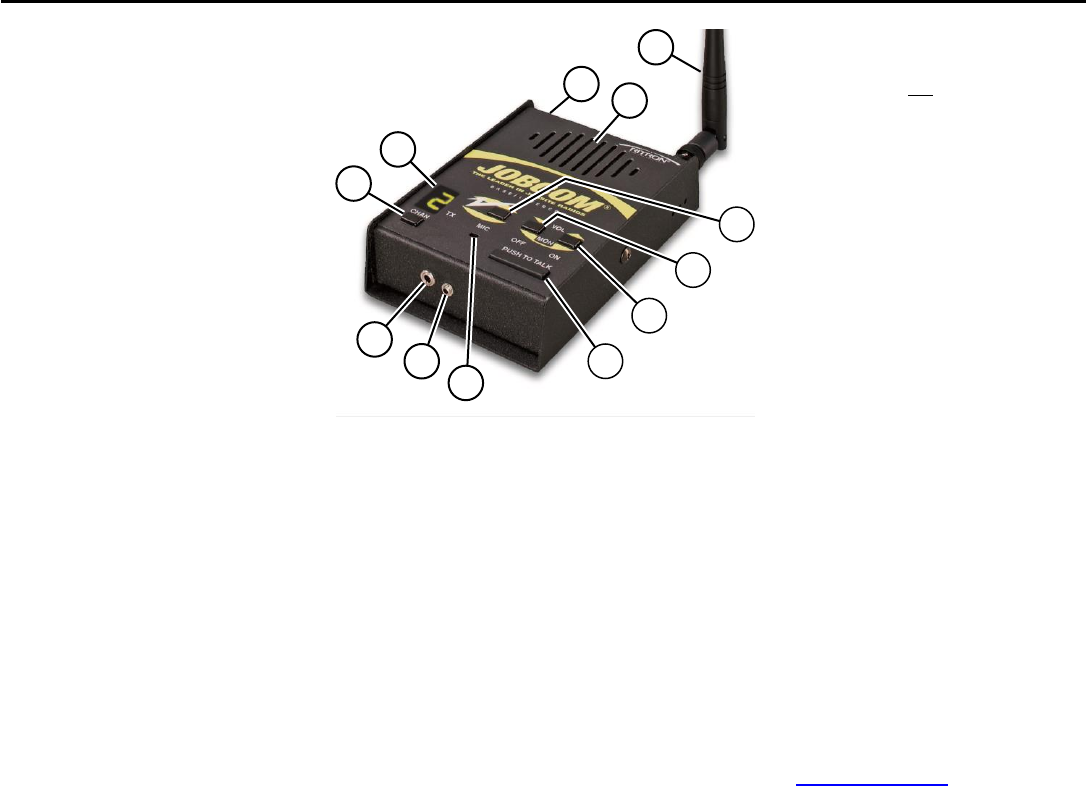
CONTROL & OPERATION
Have questions? Call 800-USA-1-USA (800-872-1872) or visit our website at www.ritron.com page 3
1 CHANNEL DISPLAY
The channel display will indicate the
current operating channel. When the
Scan Channel is selected the display
will rapidly flash the channels being
scanned, and will stop when a
channel is received. The channel
display also indicates the volume
level between 0-9 whenever a volume
control is pressed.
2 CHANNEL SELECTOR
Press the Channel Selector button
and the radio will advance the
channel. The Channel Beep will be
heard any time Channel 1 is selected.
When the Scan Channel is selected
the radio will sound the Scan Beep
and begin scanning.
3 AUDIO ACCESSORY JACK
The audio accessory jack is used to
plug in earphone options and, in
conjunction with the microphone jack,
to connect an optional remote
speaker / microphone or a single-ear
or dual-ear headset. This jack is also
used for PC programming.
4 MICROPHONE JACK
The microphone jack is used to
connect optional external
microphones and, in conjunction with
the audio accessory jack, to connect
an optional remote speaker /
microphone, or a single-ear or dual-
ear headset.
5 SPEAKER
The speaker allows you to hear calls
on your channel.
FIG-1: RADIO CONTROLS & CONNECTORS
6 POWER CONNECTOR (TOP END OF CASE)
The power connector on the top end of the radio is used
to connect power to the unit, either an external 12 VDC
supply or the RPS-1B cube power supply included with
the radio.
7 ANTENNA
The flexible antenna radiates and receives radio signals.
The antenna connects to a BNC type connector located
on the top end of the radio.
NOTE: The AFB-1545 antenna furnished with the radio
will work with VHF and UHF radios.
8 PUSH-TO-TALK SWITCH (PTT)
Press and hold the PTT when transmitting; release it to
receive.
9 “Z” BUTTON - PROGRAMMABLE
SOFT KEY
The “Z” button is capable of
performing one of a variety of
functions. These functions can be PC
programmed by your Ritron dealer
OR certain functions can be assigned
to the “Z” button by the end user.
Function options: Channel Scan,
Weather Channel, Monitor, Send 2-
Tone Code, Send Call Tone, Send
DTMF ANI (PC programmable by
your Ritron dealer).
10 VOLUME DOWN / OFF
Press the Volume Down / Off button
to decrease volume. The channel
display will indicate the volume level
as long as the Volume Down / Off
button is pressed. To turn Off the unit,
press and hold this button until the
speaker sounds a double beep.
11 ON / VOLUME UP
To turn the unit On, press the On /
Volume Up button; the speaker will
sound the Channel Beep. If the radio
turns on to the Scan Channel it will
sound the Scan Beep. Once the radio
is On, press this button to increase
volume. The channel display will
indicate the volume level as long as
the On / Volume Up button is
pressed.
12 MICROPHONE
The microphone allows your voice to
be heard in transmissions to other
radios. Speak in a normal tone;
shouting does not improve your
listeners’ reception.
1
2
3
4
5
6
7
8
9
10
11
12
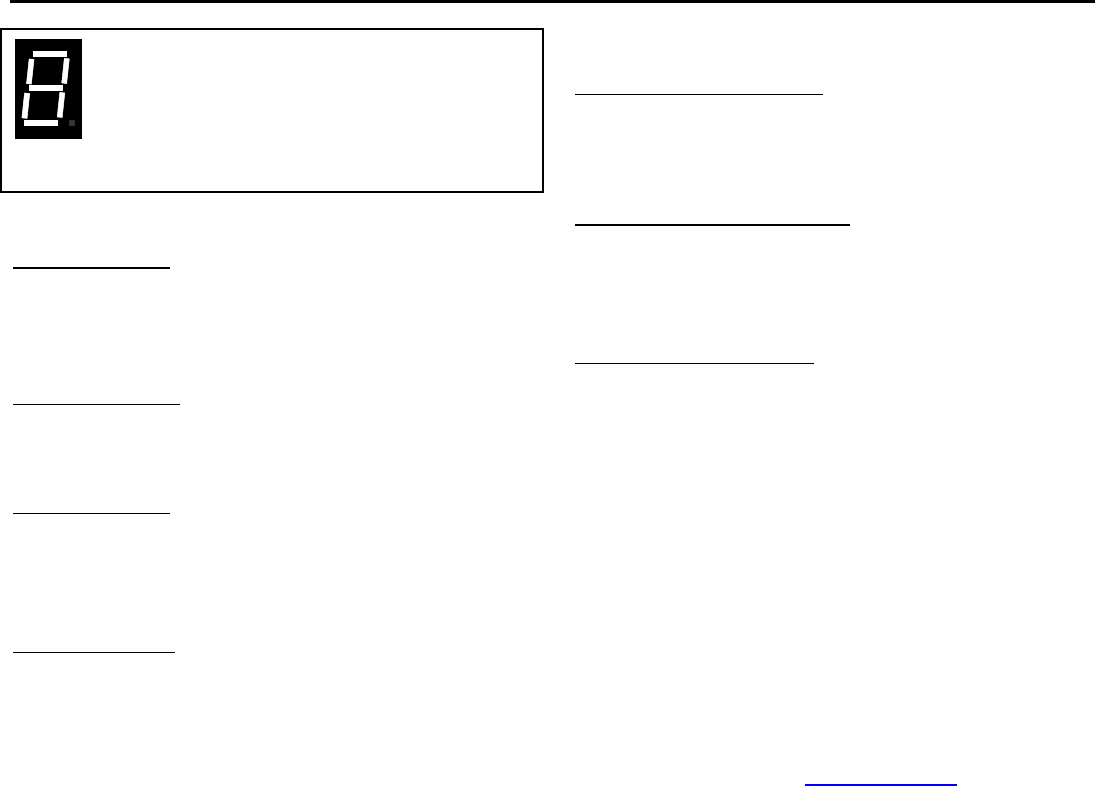
OPERATION
Have questions? Call 800-USA-1-USA (800-872-1872) or visit our website at www.ritron.com page 4
As long as the Volume Up button is held down the
volume will increase and the display will indicate the
volume level as number between 0 and 9.
When the Volume Down button is held down the
volume will decrease and the display will indicate the
volume level as a number between 9 and 0.
FIG-2: VOLUME LEVEL INDICATOR
ON-OFF VOLUME ADJUST
To turn on the radio - press the On / Volume Up button. The
radio will sound the Channel Beep. If the radio turns on to the
Scan Channel it will emit the Scan Beep. The radio will turn on to
the channel that was selected when it was last turned off.
NOTE: JBS-146i-A and JBS-446D-A turn on automatically any
time power is applied to the radio.
To adjust the volume - press the volume up or the volume down
button until you reach the desired level. The display will show the
volume level on a 0-9 scale as long as the volume button is
pressed, and you will hear any received broadcasts on the
channel.
To turn off the radio - press and hold the Off / Volume Down
button until a two tone “turn-off” beep is heard. For instant turn-
off, press the PTT button while holding the Off / Volume Down
button.
CHANNEL SELECTION
To change channels - press and release the Channel Selector
button. The radio will increment the channel, and the Channel
Display will show the new operating channel. If the highest
channel number is selected and you press the Channel Selector
button, the radio resets to channel 1 and the Channel Beep is
heard on the speaker.
If the Scan Channel is selected - the radio will sound the Scan
Beep and the Channel Display will rapidly flash the channel
numbers as they are scanned. If a signal is received the channel
display will indicate the channel number, and when the received
signal is removed the radio will wait briefly, sound the Scan
Beep, then scanning will resume as normal.
If the Weather Channel is selected - on a VHF radio the display
will light a single segment of the display that indicates which of
the seven NOAA frequencies is monitored. See the “NOAA
Weather Radio Feature” section on page 10 for details.
RECEIVE
To hear calls from other users - adjust the volume as desired.
The radio can only receive broadcasts while the Push-To-Talk
button is not being pressed. Whether or not you hear these
broadcasts depends upon the squelch settings.
There are three standard squelch modes that can be used in the
JBS / PBS “D-Series” base station.
Carrier Squelch lets you hear all broadcasts on your channel
strong enough for the radio to detect, and silences noise.
Tone Squelch uses the QC or DQC “tone squelch” format
available on the JBS / PBS. This allows you to screen out
“on-channel” broadcasts that do not carry the correct code
programmed for the radio.
2-Tone Paging can be used in conjunction with either
carrier or tone squelch to block out all calls except those
sent specifically to your radio. When the unique 2-tone
sequence programmed into the radio is decoded, the radio
will emit a series of ring tones similar to a telephone.
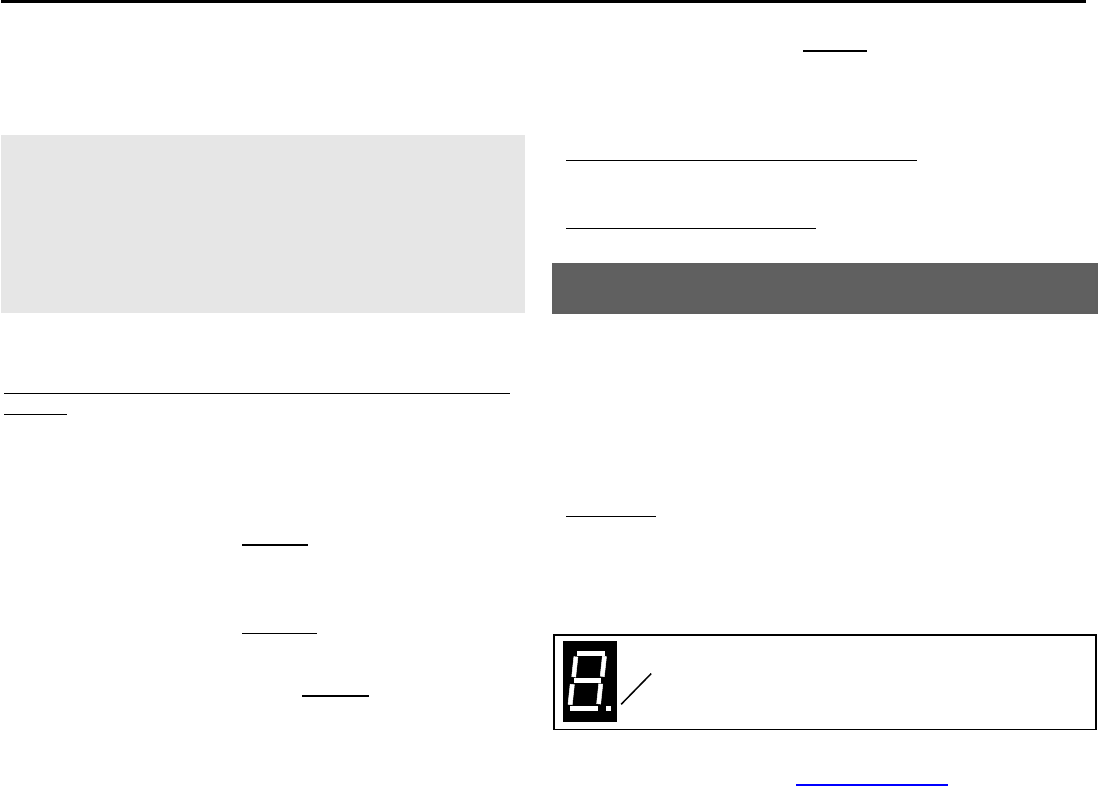
OPERATION
Have questions? Call 800-USA-1-USA (800-872-1872) or visit our website at www.ritron.com page 5
When Carrier or Tone Squelch is selected by the user, all
channels will operate in that mode. The JBS / PBS “D-Series”
base station will operate in tone squelch mode when it is first
turned on.
QC AND DQC TONE CODES
Tone codes filter out static, noise and reduce unwanted “chatter”
on radio channels. When you operate on a frequency with a tone
code, you screen out most interference. This allows you to
communicate with less interference and to hear only those users
in your radio group.
IMPORTANT! All radios in the talk group must operate on the
same frequency and tone code.
SQUELCH MODES
To activate Tone Squelch or Carrier Squelch and to Monitor the
channel - you may either simultaneously press both the On /
Volume Up and Volume Down / Off volume buttons and hold
briefly before releasing, or if the “Z” button is set for the monitor
function (see page 15), then press the “Z” button and release. To
advance to the next squelch mode simultaneously press both
volume buttons, or press the “Z” button.
1. If the base station emits a SINGLE beep, then Tone Squelch
is turned ON and you will only hear radio transmissions on
that channel with the same QC or DQC tone codes as your
base station.
2. If the base station emits a DOUBLE beep, then you are in
Carrier Squelch and you can Monitor all broadcasts on the
channel. To exit Carrier Squelch press and hold both
volume buttons until you hear the SINGLE beep.
3. If the base station emits a TRIPLE beep, then you are in 2-
TONE DECODE. You will only hear broadcasts that first send
your two unique paging tones. If you are unable to set the
base station, you have selected a channel that is not
programmed for 2-Tone Decode.
If you are unable to activate Carrier Squelch - the base station
has been programmed for Monitor Lockout. See your Ritron
dealer or contact Ritron directly to disable this option.
Using the “Z” button for Monitor - the JBS / PBS “D-Series” base
station “Z” button can be programmed for Monitor mode.
To use the “Z” button for Monitor see ‘How to Field Program
Radio Feature Codes” on page 15.
Note: It is possible that the beginning of a call might be missed
while the base station is in battery saver mode. If this
happens, ask the caller to repeat the message.
TRANSMIT
Normally, you should monitor the channel before transmitting
and talk only when the channel is clear.
To transmit - hold down the Push-To-Talk button and, with the
radio at least 6 inches away, talk into the microphone. Speak in a
normal tone, since talking louder will not improve the listener’s
reception.
Keep talk times as short and infrequent as possible to allow
others to use the channel.
A Transmit / Busy Lamp in the lower right corner of
the Channel Display lights whenever the transmitter
is activated and blinks when the channel is busy.
FIG-3: TRANSMIT / BUSY LAMP

OPERATION
Have questions? Call 800-USA-1-USA (800-872-1872) or visit our website at www.ritron.com page 6
RADIO ALERT TONES
The base station responds to certain instructions by sounding a
beep or series of tones. These tones can tell you that the radio is
working as you expect.
Power On / Self Check “OK”
When it is first turned on, the base station runs a quick “self test”
to confirm basic functions. When complete the base station will
emit the Channel Beep and the Channel Display will show the
operating channel. The base station is then ready to use.
Error Tones
However, if the “self test” detects a diagnostic error, an error
tone sounds. The error tone indicates the base station frequency
synthesizer is malfunctioning. Turn off the radio and try again.
The error tone will also sound if a channel has been
programmed for an invalid frequency.
A long, low-pitched tone means the battery voltage is too low to
operate the base station. If you cannot correct the problem,
consult an authorized Ritron service center or Ritron directly.
Squelch Mode
When you press and hold both Volume buttons at the same time,
a SINGLE beep will sound to indicate that tone squelch is on. A
DOUBLE beep means that carrier squelch is on. If the channel is
programmed for 2-Tone Code, a TRIPLE beep indicates that the
base station is in 2-Tone Decode mode.
Transmitter Time Out
A low tone followed by a higher-pitched tone sounds and the
transmitter automatically shuts off if you hold down the PTT
button longer than 60 seconds.
Battery Alert Tone
In battery powered installations: Once the battery voltage drops
below the required “operating voltage” the radio emits a long, low
tone and turns itself off.
OPTIONAL ALERT TONES
The “Display Series” base station can be programmed using the
RITRON PC Programmer for optional alert tones. See your
Ritron dealer or contact Ritron directly for programming of these
options.
Courtesy Beep
A short tone sounds at the end of each received transmission to
indicate that the channel is clear and you may transmit.
Busy Channel TX Inhibit
If a user is transmitting on your radio frequency without your
tone, you will not be allowed to transmit. The base station will
beep a series of long, low tones while the PTT is held down (like
a busy signal).
Transmit Clear to Talk Beep
A short tone sounds after the PTT has been pressed to indicate
that the base station is ready for you to begin talking.
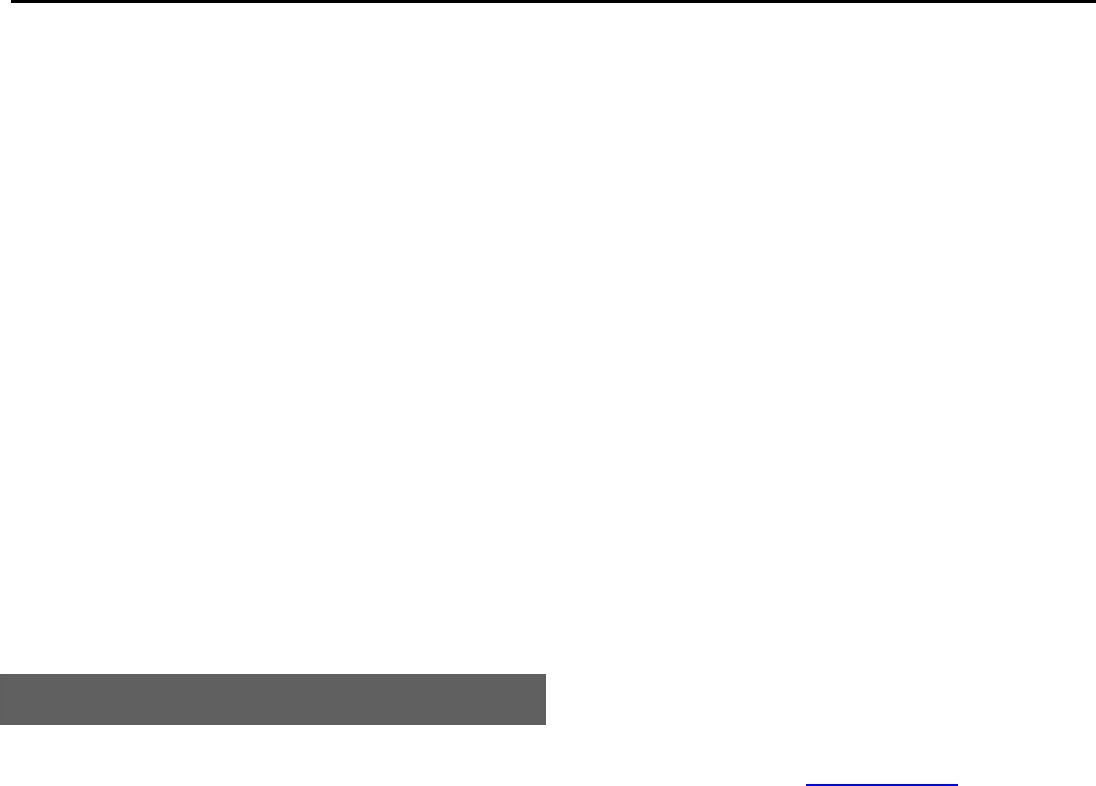
OPERATION
Have questions? Call 800-USA-1-USA (800-872-1872) or visit our website at www.ritron.com page 7
CHANNEL SCAN OPERATION
Channel scanning allows you to listen to broadcasts on your
radio channels. The JBS / PBS “Display-Series’ base station will
scan all channels programmed into the radio except the NOAA
Weather Channel.
How Scanning Works
Using the Channel Selector button, select the Scan channel. The
base station sounds the Scan Beep, and then repeatedly checks
each channel in the scan list. The channel display will show the
channel numbers as they are scanned.
When receiving a call on a channel being scanned, the base
station will stop scanning to let you hear communications on that
channel. After the transmission has ended the base station will
pause before it resumes scanning to allow you time to respond.
When transmitting from the Scan channel, the base station will
go to the last channel on which a signal was received, then
transmit. After you release the PTT the base station will pause
to allow time for a response, and then resume scanning.
Temporary Busy Channel Blocking
If one of the channels in the scan list is so busy that you want to
temporarily block it out, press the Channel Selector button while
the base station is stopped on the channel to be blocked and
hold it until scanning resumes. The blocked channel will now be
skipped in the scan list.
The blocked channel will be returned to the scan list if the base
station is turned off and then back on again, or when the radio
channel is changed using the Channel Selector button. The first
channel in the scan list cannot be blocked.
To turn Channel Scan On / Off see “How to Field Program
Radio Feature Codes” on page 15.
Last Channel Scanned Alert Tone
When changing channels with the Channel Selector button, an
alert tone will sound to indicate the last channel that received a
message when the radio was scanning. This will identify the
channel on which the last message was received, and allow
uninterrupted transmission on that channel without the
constraints of scanning. You can then press the Channel
Selector button to return to the scan channel.
Using the “Z” Button for Scan
The special feature “Z” button can be programmed to initiate
scanning. The UHF JBS-446D and PBS-446D base stations are
programmed for “Z” button Scan channel operation from the
factory.
To select the Scan Channel, press the “Z” button. The radio
sounds the Scan Beep, and scanning operation is initiated. The
Scan channel will not be accessible with the Channel Selector
button when the base station is programmed for ‘Z” button Scan
channel operation.
To return to normal channel operation, press the Channel
Selector button and the base station will return to channel 1.
To temporarily block a busy channel while scanning, press the
“Z” button while the base station is stopped on the channel to be
blocked and hold it until scanning resumes. The blocked channel
will now be skipped in the scan list.
Priority Scanning (Optional)
The “Display Series” base station can be optionally programmed
for priority scanning. Priority Scan allows you to periodically
monitor a Priority Channel, even if the base station has stopped
on another channel. This will prevent missed calls on the primary
operating channel when in scan mode.

OPERATION
Have questions? Call 800-USA-1-USA (800-872-1872) or visit our website at www.ritron.com page 8
With Priority Scan enabled:
The first channel in the scan list is the Priority Channel.
The radio checks the Priority Channel every two seconds to
check for activity. This time is programmable and can be set
for 1 - 8 seconds.
The base station can be programmed to transmit only on the
Priority Channel when scanning.
The base station can be programmed to sound a Priority
Channel Beep whenever the base station receives on the
Priority Channel when scanning.
See your Ritron dealer or contact Ritron directly for PC
programming of this option.
2-TONE DECODE OPERATION
To use 2-Tone Decode the “Display Series” base station
must be PC programmed for this option, the radio does not
operate with 2-Tone decoding as it is received from the factory.
See your Ritron dealer or contact Ritron directly for PC
programming of this option. This feature allows the base station
to act as a monitor receiver.
To activate 2-Tone Decode you must first select a radio channel
that has been PC programmed for 2-Tone Decode. The factory
default setting will automatically activate 2-Tone Decode any
time the 2-Tone Decode channel is selected. If not,
simultaneously press both of the volume buttons and hold briefly
before releasing. The radio sounds three beeps when 2-Tone
Decode is turned on.
If you are unable to set the base station, you have selected a
channel that is not programmed for 2-Tone Decode.
When the base station decodes an incoming 2-Tone signal it will
emit a “ring’ tone similar to a telephone and the display will show
a “C” to indicate that a call has been received. You can now
proceed with normal two-way communication until the 2-Tone
Decode feature has been reset. The “ring” tone will sound every
time a 2-Tone signal is decoded.
The display will show a “C” to indicate that a 2-Tone call
has been received.
FIG-4: 2-TONE CALL ALERT
To reset 2-Tone Decode after receiving a call: Simultaneously
press both of the volume buttons and hold briefly before
releasing. The base station sounds three beeps when 2-Tone
Decode is reset and the display will show the channel number.
The base station can be optionally programmed to automatically
reset if a call is not answered within 15 seconds.
2-Tone Decode channels can be programmed to:
Automatically set the base station for 2-Tone Decode mode
whenever the channel is selected.
Automatically reset if a 2-Tone Decode is not answered
within 15 seconds.
Automatically place the receiver into carrier squelch “monitor”
mode whenever a 2-Tone Decode has been decoded.
Send a transpond tone back to the transmitting station to
confirm that the 2-Tone signal has been received.
Decode an All Call tone.
Decode a Group Call if the first tone is sent for an extended
period of time.

OPERATION
Have questions? Call 800-USA-1-USA (800-872-1872) or visit our website at www.ritron.com page 9
“Z” BUTTON - PROGRAMMABLE SOFT KEY
The “Z” button is capable performing one of a variety of
functions. These functions can be PC programmed by your
dealer OR certain functions can also be assigned to the “Z”
button by the end user. Function options: Channel Scan,
Weather Channel, Monitor, Send 2-Tone Code, Send Call Tone,
Send DTMF ANI (PC programmable by your Ritron dealer).
Refer to the Dealer PC programmer HELP file for specific “Z”
button programming instructions.
To assign the “Z” Button for one of these features:
Scan Weather Monitor
Call Tone Pre-set 2-Tone Encode
see “How to Field Program Radio Feature Codes” on page 15.
SCAN
The UHF PBS-446D and JBS-446D base stations are
programmed for “Z” button Channel Scan operation from the
factory.
See “Using the “Z” Button for Scan” on page 7.
WEATHER
The “Z” button on the VHF JBS-146i base stations are
programmed for Weather Channel operation from the factory.
This option is only available on VHF band radios.
See “Using the “Z” Button for Weather Channel” on page 11.
MONITOR
The “Z” button can be programmed to function as a MONITOR
button. See page 15 to select this option.
See “Squelch Modes” to Set Carrier, Tone, or 2-Tone Paging
Functions on page 5.
CALL TONE
When the “Z” button is pressed the radio transmits a Call Tone
on the channel currently selected. If you continue to hold the “Z’
button down, the transmitter will remain active and voice
communications can be made after the Call Tone has been sent.
This feature is helpful when the receiving base station is in a
high noise environment and may not hear a voice transmission.
2-TONE ENCODE OPERATION
Pressing the “Z” button causes the base station to transmit a
unique 2-Tone Code that can be programmed separately for
each channel. The 2-Tone Code will be heard on the speaker,
and if you continue to hold the “Z” button down, the transmitter
will remain active and voice communications will be possible
after the 2-Tone Code has been sent.
Use the PTT button to transmit messages without the 2-Tone
Code.
If a channel is not programmed to encode a 2-Tone signal the
“Z” button will function as a PTT button.
See Special Application for Field Programming the 9 Pre-set
2-Tone Codes on page 19.
DTMF ANI ON TRANSMIT
This feature must be PC Programmed by your Ritron dealer.
Pressing the “Z” button causes the radio to transmit a unique
DTMF ANI string that can be programmed separately for each
channel. The DTMF string will be heard on the speaker, and if
you continue to hold the “Z” button down, the transmitter will
remain active and voice communications will be possible after
the DTMF ANI string has been sent.
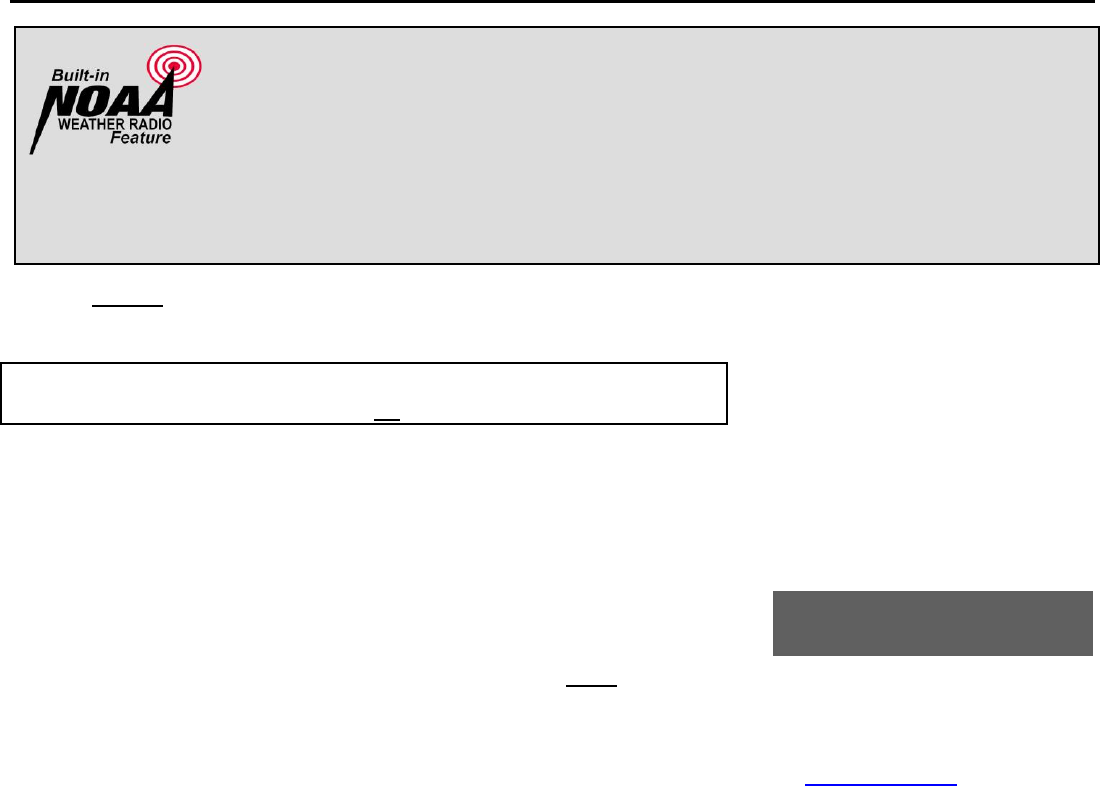
NOAA WEATHER RADIO FEATURE
Have questions? Call 800-USA-1-USA (800-872-1872) or visit our website at www.ritron.com page 10
HOW TO SELECT YOUR LOCAL NOAA WEATHER FREQUENCY (VHF MODELS ONLY)
The base station is shipped from the factory without a NOAA frequency selected. You must first
select your local NOAA frequency to activate NOAA weather features. Follow steps 1-7 below.
VHF models of the JBS / PBS “Display Series” base station can hear weather forecasts from the
National Weather Service which are broadcast on one of the seven NOAA weather frequencies. In
some areas you may be able to receive more than one broadcast.
1. Follow the steps in FIG-5 on page 11 to place the radio into the Weather Frequency Select mode.
2. The base station will scan to the first NOAA frequency where a broadcast is present. The
display will light a single segment to indicate the NOAA frequency per FIG-6 on page 11.
3. Monitor the channel for a few minutes to be sure it is the broadcast for your local area.
4. Press the “Z” button to scan for the presence of any other NOAA broadcasts, monitoring each
broadcast and noting the frequency as indicated by the display.
5. Using the “Z” button, select the local NOAA frequency you would like your radio to operate on.
6. Turn the base station off by pressing the Volume Down / Off button.
7. When the base station is turned back on all weather features will operate on the selected
NOAA frequency.
NOTE: If the base station is moved, for example, to another state you must re-train your base
station with a new local NOAA frequency.
NOAA Weather Radio (NWR) is a nationwide network of radio stations broadcasting continuous weather information direct
from a nearby National Weather Service office. NWR broadcasts National Weather Service warnings, watches, forecasts
and other hazard information 24 hours a day.
Working with the Federal Communication Commission’s (FCC) Emergency Alert System, NWR is an “all hazards” radio
network, making it your single source for comprehensive weather and emergency information. NWR also broadcasts
warning and post-event information for all types of hazards—both natural (such as earthquakes and volcano activity) and
environmental (such as chemical releases or oil spills).
Known as the “Voice of the National Weather Service,” NWR is provided as a public service by the National Oceanic & Atmospheric Administration
(NOAA), part of the Department of Commerce. NWR includes more than 750 transmitters, covering all 50 states, adjacent coastal waters, Puerto
Rico, the U.S. Virgin Islands, and the U.S. Pacific Territories. NWR requires a special radio receiver or scanner capable of picking up the signal.
Broadcasts are found in the public service band at these seven frequencies (MHz): 162.400, 162.425, 162.450, 162.475, 162.500, 162.525, 162.550.
NOAA WEATHER FEATURE
After you have selected a NOAA weather
frequency on your VHF model base
station, an extra channel is automatically
created exclusively for listening to
National Weather Service broadcasts.
Repeatedly pressing the Channel button
will advance through your base station
talk channels. NOAA Weather will be
your last channel, and the display will
light the segment representing the
selected NOAA frequency.
If you do not want the NOAA Weather
feature, it can be turned off through Field
Programming.
To turn NOAA Weather Feature On /
Off see “How to Program Radio
Feature Codes” on page 15.
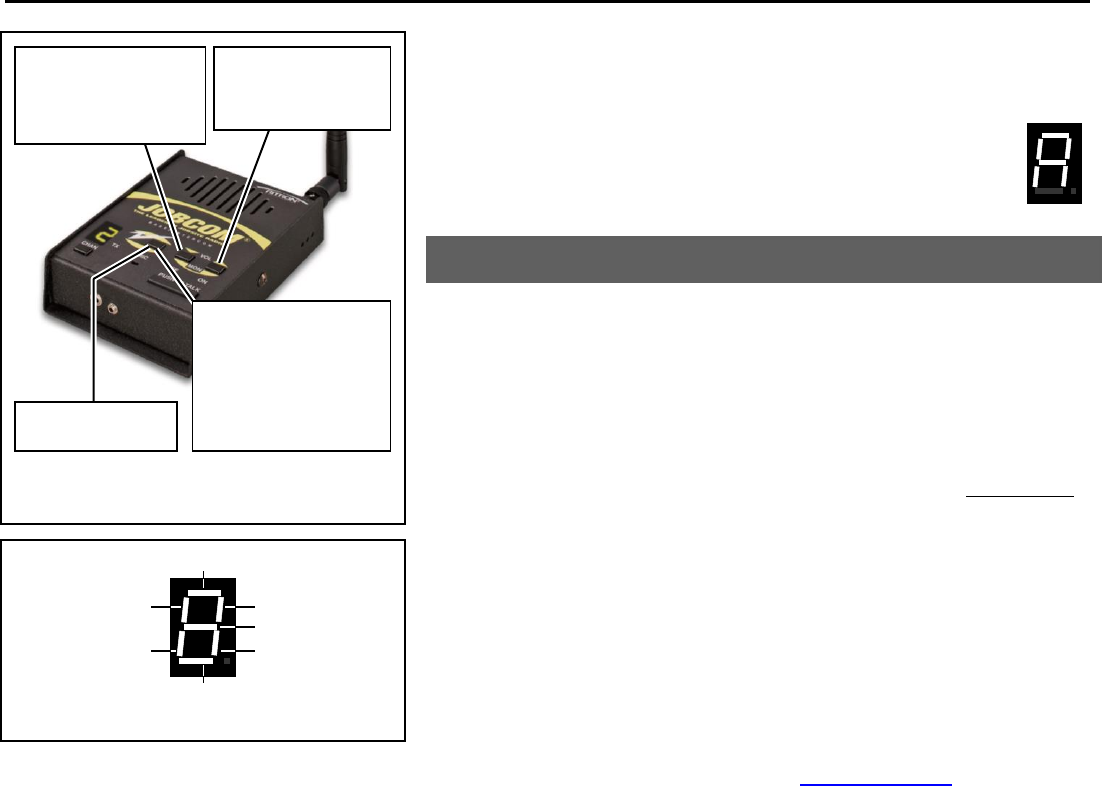
NOAA WEATHER RADIO FEATURE
Have questions? Call 800-USA-1-USA (800-872-1872) or visit our website at www.ritron.com page 11
NOAA WEATHER ALERT FEATURE
Once a NOAA weather frequency has been selected on your VHF model base station it will
listen for emergency broadcasts from the National Weather Service, regardless of which
channel you are on.
An alert tone will sound in the speaker, the display will show an “A” (as shown),
and the National Weather Service emergency broadcast will be heard - advising
you of threatening weather conditions.
NOTE: NOAA sends a test alert tone once each week. Your base station will
respond to this alert.
To turn Weather NOAA Alert On / Off see “How To Field Program Radio Feature
Codes” on page 15.
Pressing the Channel button will return you to your normal talk channel.
If you do not want the NOAA Weather Alert feature, it can be turned off through Field
Programming, refer to page 15.
USING THE “Z” BUTTON TO ACCESS NOAA WEATHER
The VHF JBS-146i base stations are programmed for “Z” button NOAA Weather operation
from the factory. This option is only available on VHF band base stations.
To select NOAA Weather, press the “Z” button. The base station will scan to the 1st
NOAA frequency where a broadcast is present. The display will light a single segment
to indicate the NOAA frequency per FIG-6. If the base station has been pre-set for your
local NOAA weather frequency, the base station will go directly to that frequency when
the “Z” button is 1st pressed.
With any subsequent press of the “Z” button the base station will scan to the next active
NOAA frequency.
When the “Z” button is programmed to access NOAA Weather, the feature will no
longer be accessible with the Channel Selector button.
To return to a normal talk channel operation, press the Channel Selector button. The
base station will return to the last talk channel you operated on.
1. Press & hold the
Volume Down / Off
button until the
“Radio Off” tones are
heard, then release.
2. Press & hold the
“Z” button.
3. Press & release the
On / Volume Up
button – the radio
will start beeping.
4. Continue holding the
“Z” button until the
beeping stops, then
release it and listen.
5. To find the next active
Weather Channel,
press and release the
“Z” button.
FIG-5: SELECTING YOUR LOCAL
NOAA WEATHER FREQUENCY
162.450 MHz
162.475 MHz 162.425 MHz
162.400 MHz
162.500 MHz 162.550 MHz
162.525 MHz
FIG-6: NOAA FREQUENCIES

RADIO PROGRAMMING
Have questions? Call 800-USA-1-USA (800-872-1872) or visit our website at www.ritron.com page 12
HOW TO READOUT FIELD PROGRAMMABLE FREQUENCY & TONE CODES
In our example, channel 3 of a UHF radio is programmed to operate on the “Brown Dot”
frequency of 464.500 MHz (Frequency code “04”) with 100.0 Hz tone (Tone code “12”).
1. Place the radio into Program / Readout Mode by following the instructions
in FIG-7 at left. A “P” will appear on the LED display as you enter program
mode.
2. Release the Push-to-talk button after the beeping has stopped. The radio
will display a series of six characters for Radio Identification, with each
character separated by a hyphen. The 1st two characters indicate the
model number, the 3rd and 4th characters indicate the radio type, and
the 5th and 6th characters indicate the firmware revision.
In this example: Model: 27
Radio Type: 31
Firmware Revision: 04
NOTE: Radio models with firmware revisions prior to 16.01 do not
display the Radio Identification sequence.
3. After the Radio Identification has been displayed the digit 1 will appear,
followed by a hyphen, and the radio will emit a triple beep indicating that
the radio is in program mode and channel 1 is selected.
4. Press the Channel Selector button to select the channel to be read out.
The channel number will appear briefly on the display as you step through
the channels. When you have settled on a channel a hyphen will appear
across the center of the display to indicate that it is ready for readout.
5. Press and release the On / Volume Up button. The radio will begin to
display a series of four digits; with each digit separated by a hyphen.
The 1st and 2nd digits indicate frequency code; see Table 1 on page 14.
The 3rd and 4th digits indicate the tone code; see Table 2 on page 15.
If a 5th digit is displayed, the channel has been programmed for DQC and
the last three digits indicate the DQC code; see Table 3 on page 15.
If more than 5 digits are displayed refer to page 19.
6. If the channel is PC-programmed for any frequency not listed in Table 1
on page 14, an error tone will sound and an “E” will appear on the
display.
7. To readout another channel, repeat steps 4 through 6.
8. Turn the radio OFF and then ON again—the radio is now ready to use.
1. Press & hold the
Volume Down / Off
button until the
“Radio Off” tones are
heard, then release.
2. Press & hold
the Push-to-
Talk button.
3. Press & release
the On / Volume
Up button – the
radio will start
beeping.
4. Continue holding the
Push-to-Talk button
until the beeping stops,
then release it and
listen.
5. The radio will emit a
triple tone: It is now in
Program / Readout
Mode.
FIG-7: HOW TO PLACE THE RADIO IN
PROGRAM / READOUT MODE
IMPORTANT
To talk to other users in your group, all
radios must be set to the same frequency
and Interference Eliminator codes.
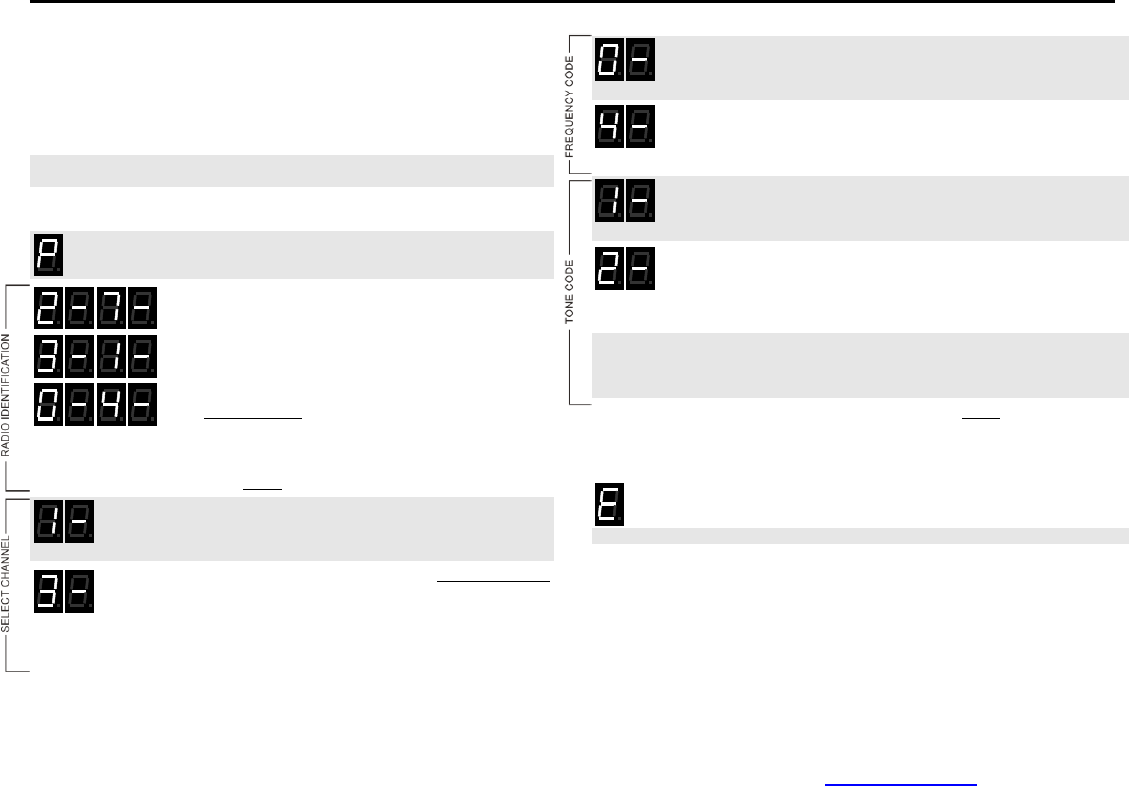
RADIO PROGRAMMING
Have questions? Call 800-USA-1-USA (800-872-1872) or visit our website at www.ritron.com page 13
HOW TO FIELD PROGRAM FREQUENCY & TONE CODES
To match other radios, the owner can select Frequency and Tone Codes from
Tables 1, 2, and 3 on pages 14 and 15.
In our example we will program channel 3 of a UHF radio to operate on the “Brown
Dot” frequency of 464.500 MHz (Frequency code “04”) with 100.0 Hz tone (Tone
code “12”).
1. Refer to Table 1 on page 14 to determine the two digit
frequency code and write it down.
2. Refer to Table 2 on page 15 to determine the two digit
tone code for 100.0 Hz and write it down.
3. Place the radio into Program / Readout Mode by
following the instructions in FIG-7 on page 12. A “P” will
appear on the LED display as you enter program mode.
4. Release the Push-to-talk button after the beeping has
stopped. The radio will display a series of six characters
for Radio Identification, with each character separated
by a hyphen. The 1st two characters indicate the model
number, the 3rd and 4th characters indicate the radio
type, and the 5th and 6th characters indicate the
firmware revision.
In this example: Model: 27
Radio Type: 31
Firmware Revision: 04
NOTE: Radio models with firmware revisions prior to
16.01 do not display the Radio Identification sequence.
5. After the Radio Identification has been displayed the
digit 1 will appear, followed by a hyphen, and the radio
will emit a triple beep indicating that the radio is in
program mode and channel 1 is selected.
6. Press the Channel Selector button to select the channel
to be programmed. The channel number will show
briefly on the channel display as you step through the
channels. When you have settled on a channel the
display will show a hyphen to indicate that it is ready for
programming.
7. Enter the 1st digit of the frequency code by clicking the PTT button
until the channel display shows the desired number. Pause - the
radio will sound a low tone and show a hyphen across the center of
the display to indicate that it is ready to accept the next digit.
8. Enter the 2nd digit of the frequency code by clicking the PTT button
until the channel display shows the desired number. Pause - the
radio will sound a low tone and show a hyphen across the center of
the display to indicate that it is ready to accept the next digit
9. Enter the 1st digit of the tone code (or 1st digit of the DQC code) by
clicking the PTT button until the channel display shows the desired
number. Pause - the radio will sound a low tone and show a hyphen
on the display to indicate that it is ready to accept the next digit.
10. Enter the 2nd digit of the tone code (or 2nd digit of the DQC code)
by clicking the PTT button until the channel display shows the
desired number. Pause - the radio will sound a low tone and show a
hyphen on the display to indicate that it is ready to accept the next
digit.
11. FOR DQC CODES ONLY - Enter the 3rd digit of the DQC code by
clicking the PTT button until the channel display shows the desired
number. Pause - the radio will sound a low tone and show a hyphen
on the display to indicate that it is ready to accept the next digit.
12. Press and release the On / Volume Up to SAVE your programming
entry. The LED display will briefly show the channel number you
have just programmed and the radio will sound a triple beep to
indicate that programming was successful.
NOTE: An error tone will sound if you attempt to save an incorrect
code and an “E” will appear on the display. Turn the radio OFF,
check the digits you are attempting to enter, then start over.
13. To program another channel, repeat steps 6 through 12.
14. Turn the radio OFF and then ON again—the radio is now ready to
use.
NOTES:
a. YOU MUST enter “44” to enter “No Code” interference eliminator to match
radios not having tone codes. Refer to Table 2 on page 15.
b. If the radio does not sound a confirming triple tone when you attempt to enter
Program / Readout Mode, the radio was factory or dealer customized to
disable programming. Consult the radio owner or your dealer.
04
12

RADIO PROGRAMMING
Have questions? Call 800-USA-1-USA (800-872-1872) or visit our website at www.ritron.com page 14
TABLE 1: PROGRAMMABLE FREQUENCY CODES
VHF Business Band
Code Color Band
No. MHz Dot Width
03 151.6250 Red Dot 12.5 †
04 151.9550 Purple Dot 12.5 †
05 151.9250 12.5 †
06 154.5400 12.5 †
07 154.5150 12.5 †
08 154.6550 12.5 †
09 151.6850 12.5 †
10 151.7150 12.5 †
11 151.7750 12.5 †
12 151.8050 12.5 †
13 151.8350 12.5 †
14 151.8950 12.5 †
15 154.4900 12.5 †
16 151.6550 12.5 †
17 151.7450 12.5 †
18 151.8650 12.5 †
24 151.7000 12.5
25 151.7600 12.5
26 152.7000 12.5 †
27 152.8850 12.5
28 152.9150 12.5
29 152.9450 12.5
30 151.5125 12.5
31 154.5275 12.5
32 153.0050 12.5
33 158.4000 12.5
34 158.4075 12.5
00 DELETE Code*
Canadian VHF Business Band Models
01 151.0550 25.0
02 151.1150 25.0
British Columbia VHF Models
01 154.1000 25.0
02 158.9400 25.0
Canadian UHF Business Band Models
01 458.6625 25.0
02 469.2625 25.0
UHF Business Band
Code Color Band
No. MHz Dot Width
09 469.2625 12.5 †
10 462.5750 White Dot 12.5 †
11 462.6250 Black Dot 12.5 †
12 462.6750 Orange Dot 12.5 †
13 464.3250 12.5 †
14 464.8250 12.5 †
15 469.5000 12.5 †
16 469.5500 12.5 †
17 463.2625 12.5 †
18 464.9125 12.5 †
19 464.6000 12.5 †
20 464.7000 12.5 †
21 462.7250 12.5 †
22 464.5000 Brown Dot 12.5
23 464.5500 Yellow Dot 12.5
24 467.7625 J 12.5
25 467.8125 K 12.5
26 467.8500 Silver Star 12.5
27 467.8750 Gold Star 12.5
28 467.9000 Red Star 12.5
29 467.9250 Blue Star 12.5
30 461.0375 12.5
31 461.0625 12.5
32 461.0875 12.5
33 461.1125 12.5
34 461.1375 12.5
35 461.1625 12.5
36 461.1875 12.5
37 461.2125 12.5
38 461.2375 12.5
39 461.2625 12.5
40 461.2875 12.5
41 461.3125 12.5
42 461.3375 12.5
43 461.3625 12.5
44 462.7625 12.5
45 462.7875 12.5
46 462.8125 12.5
47 462.8375 12.5
48 462.8625 12.5
49 462.8875 12.5
50 462.9125 12.5
51 464.4875 12.5
52 464.5125 12.5
UHF Business Band
Code Color Band
No. MHz Dot Width
53 464.5375 12.5
54 464.5625 12.5
55 466.0375 12.5
56 466.0625 12.5
57 466.0875 12.5
58 466.1125 12.5
59 466.1375 12.5
60 466.1625 12.5
61 466.1875 12.5
62 466.2125 12.5
63 466.2375 12.5
64 466.2625 12.5
65 466.2875 12.5
66 466.3125 12.5
67 466.3375 12.5
68 466.3625 12.5
69 467.7875 12.5
70 467.8375 12.5
71 467.8625 12.5
72 467.8875 12.5
73 467.9125 12.5
74 469.4875 12.5
75 469.5125 12.5
76 469.5375 12.5
77 469.5625 12.5
78 462.1875 12.5
79 462.4625 12.5
80 462.4875 12.5
81 462.5125 12.5
82 467.1875 12.5
83 467.4625 12.5
84 467.4875 12.5
85 467.5125 12.5
86 451.1875 12.5
87 451.2375 12.5
88 451.2875 12.5
89 451.3375 12.5
90 451.4375 12.5
91 451.5375 12.5
92 451.6375 12.5
93 452.3125 12.5
94 452.5375 12.5
95 452.4125 12.5
96 452.5125 12.5
UHF Business Band
Code Color Band
No. MHz Dot Width
97 452.7625 12.5
98 452.8625 12.5
99 456.1875 12.5
100 456.2375 12.5
101 456.2875 12.5
102 468.2125 12.5
103 468.2625 12.5
104 468.3125 12.5
105 468.3625 12.5
106 468.4125 12.5
107 468.4625 12.5
108 468.5125 12.5
109 468.5625 12.5
110 468.6125 12.5
111 468.6625 12.5
112 456.3375 12.5
113 456.4375 12.5
114 456.5375 12.5
115 456.6375 12.5
116 457.3125 12.5
117 457.4125 12.5
118 457.5125 12.5
119 457.7625 12.5
120 457.8625 12.5
121 461.3175 12.5
122 464.8375 12.5
00 DELETE Code*
* 2-digit Frequency placeholder code (Refer
to “How to Delete a Channel” on page
16)
† Frequency code was 25 KHz bandwidth
prior to the 2013 FCC Narrowband
Mandate.
• 12.5 kHz indicates a narrow band channel,
25 kHz indicates a wide band channel.
• If a channel has been PC programmed to a
non-table frequencies it cannot be changed
via field programming

RADIO PROGRAMMING
Have questions? Call 800-USA-1-USA (800-872-1872) or visit our website at www.ritron.com page 15
TABLE 2: INTERFERENCE ELIMINATOR
PROGRAMMABLE QC TONE
Code
Hz
Code
Hz
Code
Hz
01
67.0
18
123.0
35
225.7
02
71.9
19
127.3
36
233.6
03
74.4
20
131.8
37
241.8
04
77.0
21
136.5
38
250.3
05
79.7
22
141.3
39
69.4
06
82.5
23
146.2
40
159.8
07
85.4
24
151.4
41
165.5
08
88.5
25
156.7
42
171.3
09
91.5
26
162.2
43
177.3
10
94.8
27
167.9
44 No Tone
11
97.4
28
173.8
45
183.5
12
100.0
29
179.9
46
189.9
13
103.5
30
186.2
47
196.6
14
107.2
31
192.8
48
199.5
15
110.9
32
203.5
49
206.5
16
114.8
33
210.7
50
229.1
17
118.8
34
218.1
51
254.1
00
Delete
TABLE 3: DIGITAL INTERFERENCE ELIMINATOR
PROGRAMMABLE DQC TONE
CODE NUMBERS
023
072
152
244
311
412
466
632
025
073
155
245
315
413
503
645
026
074
156
246
325
423
506
654
031
114
162
251
331
431
516
662
032
115
165
252
332
432
523
664
036
116
172
255
343
445
532
703
043
122
174
261
346
446
546
712
047
125
205
263
351
452
565
723
051
131
212
265
356
454
606
731
053
132
223
266
364
455
612
732
054
134
225
271
365
462
624
734
065
143
226
274
371
464
627
743
071
145
243
306
411
465
631
754
HOW TO FIELD PROGRAM RADIO FEATURE CODES
1. Follow the instructions in FIG-7 on page 12 to place the base station in the Program /
Readout Mode.
2. Using the PTT (push-to-talk) button and the LED display, enter the single digit code
from Table 4 below for the option to be programmed.
3. Pause—the display will change and show a hyphen, you will also hear a short low
tone.
4. Press and release the On / Volume Up to SAVE your programming entry. The base
station will sound a triple beep to indicate that programming was successful.
5. Turn the base station OFF and then ON again—the base station is now ready to use.
TABLE 4: Radio Feature Codes
Option
Code
Turn Channel Scan
ON
1
Turn Channel Scan
OFF
2
Turn Weather Channel
ON
3
Turn Weather Channel
OFF
4
Turn Weather Alert
ON
5
Turn Weather Alert
OFF
6
Assign SCAN option to Z Button
7
Assign WEATHER option to Z Button
8
Assign MONITOR option to Z Button
9
Assign CALL TONE option to Z Button
0
NOTES:
1. If Code 7 is selected Codes 1 & 2 will have no effect
2. If Code 8 is selected, Codes 3 & 4 will have no effect
3. Code 0 is entered by pressing the PTT 10 times
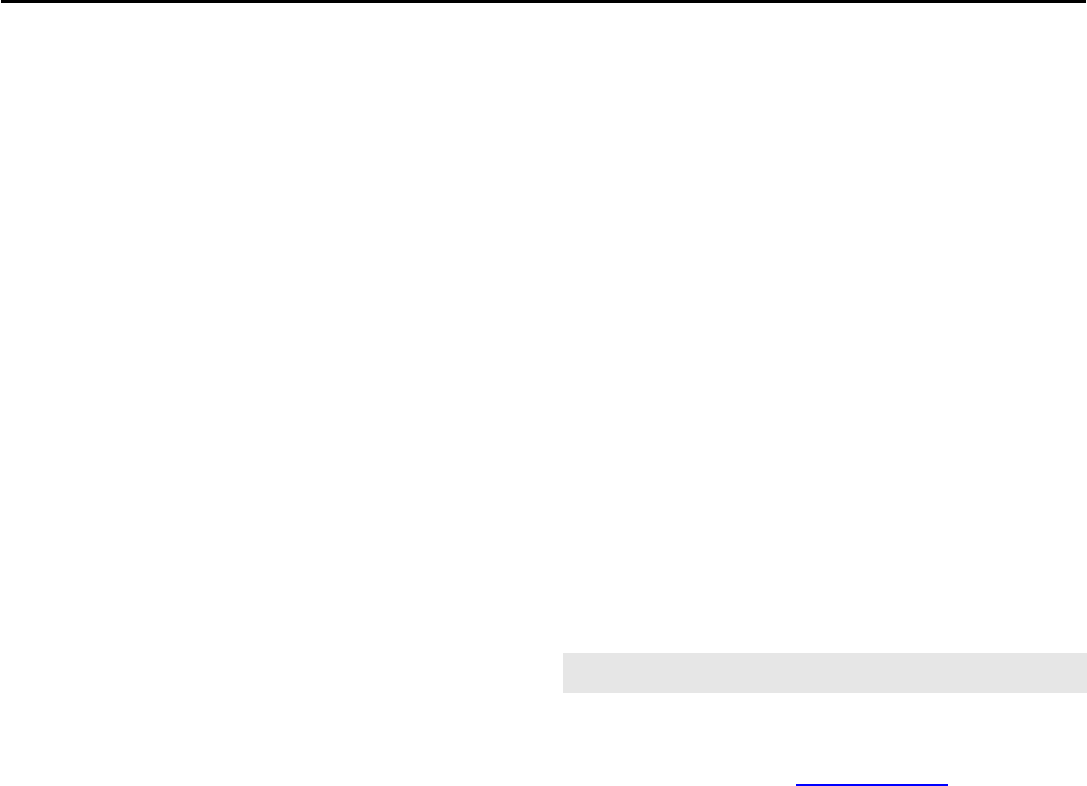
RADIO PROGRAMMING
Have questions? Call 800-USA-1-USA (800-872-1872) or visit our website at www.ritron.com page 16
HOW TO DELETE A CHANNEL
Following the instructions in “How to Field Program Frequency &
Tone Codes” on page 13, enter a Frequency Code of “00” and a
Tone Code of “00”. Once a channel has been deleted it is no longer
available with the Channel Selector.
A deleted channel can be added back at any time. To add a deleted
channel back, follow the instructions in “How to Field Program
Frequency & Tone Codes” on page 13.
PC PROGRAMMABLE FEATURES
The “Display Series” base station has many features that are only
available through PC programming. See your Ritron dealer or
contact Ritron directly for PC programming of these options.
Receive and Transmit Frequency on any channel can be
programmed to any valid frequency within its designated band. (See
“Display Series Model Numbers” for frequency bands)
Squelch Tightener on any channel can adjust carrier squelch UP to
block distant signals or DOWN to hear more distant signals.
Wide or Narrow Band transmit operation can be set per channel.
Refer to the section FCC Narrowband Mandate to see if your radio is
capable of wideband transmit operation.
Monitor Lock Out can be set on any channel to prevent monitoring
of the channel, only broadcasts with the correct QC or DQC code
can be heard.
Transmit Inhibit on Busy Channel can be set on any channel to
prevent transmitting when a broadcast is present on the receiver that
does not carry the correct code. This feature is usually used in
conjunction with Monitor Lock Out.
Transmit Time Out time can be changed.
Power Saver “sleep” time can be set, or power saver can be
disabled.
Courtesy Beep sounds a short tone at the end of each received
transmission to indicate that the channel is clear and you may
transmit.
Transmit Clear To Talk Beep Any channel can be set to sound a
short tone after the PTT has been pressed to indicate that the base
station is ready for you to begin talking.
Disable Field Programming to allow only PC programming.
Channel Scan can be programmed or edited to include any of the
radio channels, even channels that are not selected with the
Channel Selector button. Other programmable scan features include
scan resume delay time, busy channel blocking, last active channel
beeps, and priority scanning options.
2-Tone Paging Decode can be set on any channel. Programmable
options include the setting of the 2-Tone frequencies and duration,
All Call, Group Call, Call Transpond, automatic setting of 2-Tone
Decode when the channel is selected, automatic reset of the 2-Tone
Decode if a call is not answered within 15 seconds, and
automatically set the base station to carrier squelch mode after a 2-
Tone signal is received.
* 2-Tone Encode Each channel can be programmed with a unique
pair of 2-Tone encode frequencies between 300-1500 Hz. Pressing
the “Z” button will send the 2-Tone Code.
* DTMF ANI A unique DTMF ANI string can be programmed
separately for each channel. Pressing the “Z” button will send the
DTMF ANI.
* Note: A channel can not be programmed to do both DTMF ANI
and 2-Tone Encode.

!! CAUTIONS – ALL RADIOS !!
Have questions? Call 800-USA-1-USA (800-872-1872) or visit our website at www.ritron.com page 17
OBSERVE CAUTION IN THE FOLLOWING
ENVIRONMENTS TO MAXIMIZE THE LIFE
OF YOUR RADIO EQUIPMENT:
LOCATION: Be aware that this radio and /
or antenna may create interference with, or
be interfered with, by nearby electronic
equipment such as computers, monitors,
keyboards, electronic telephones and other
sensitive devices. Either move the
equipment or use a remote antenna to
separate components sufficiently to stop or
reduce interference.
MOISTURE: “Display Series” base radios
are not waterproof. DO NOT directly expose
them to rain or excessive moisture.
CHEMICALS: Detergents, alcohol, aerosol
sprays or petroleum products can damage
the radio case. DO NOT use petroleum
solvents of any kind; use a soft cloth
moistened with water to clean the case.
EXTREME HEAT: High temperatures can
damage the radio and its components. DO
NOT expose the units to extreme heat or
leave them in direct sunlight.
EXCESSIVE TRANSMISSIONS: DO NOT
hold the Push-To-Talk switch down longer
than necessary during transmission
intervals.
VIBRATION / SHOCK: Although your
“Display Series” base radio is designed to be
rugged, it will not survive excessive abuse.
Avoid dropping the radio.
EXPOSURE TO RADIO FREQUENCY ENERGY:
These products generate radio frequency (RF) energy when the PTT button on the
front of the unit is depressed. The product has been evaluated for compliance with
the maximum permissible exposure limits for RF energy at the maximum power
rating of the unit when using antennas available from RITRON. Antennas other than
those mentioned below have not been tested for compliance and may or may not
meet the exposure limits at the distances given. Higher gain antennas are capable of
generating higher fields in the strongest part of their field and would, therefore,
require a greater separation from the antenna.
JBS-446D: Using the AFB-1545 antenna included with the product at the 20 cm (7.9
inches) minimum expected separation distance and greater, the maximum RF
exposure is well below the General Population/Uncontrolled limits. Antennas other
than those available from RITRON have not been tested for compliance and may or
may not meet the exposure limits at the distances given. Higher gain antennas are
capable of generating higher fields in the strongest part of their field and would,
therefore, require a greater separation from the antenna. This product is not to be
used by the general public in an uncontrolled environment unless compliance with
the Uncontrolled/General Population limits for RF exposure can be assured.
To limit exposure to RF energy to levels below the limit, please observe the following:
Use only the antenna(s) available from RITRON for these models. DO NOT
operate the radio without an antenna.
Keep talk times as short and infrequent as possible. DO NOT depress the PTT
button when not actually wishing to transmit. These radios are equipped with an
internal timer to limit continuous transmit times.
When transmitting, make certain that the distance limits for the particular model in
use are observed.
DO NOT allow children to operate the radio.
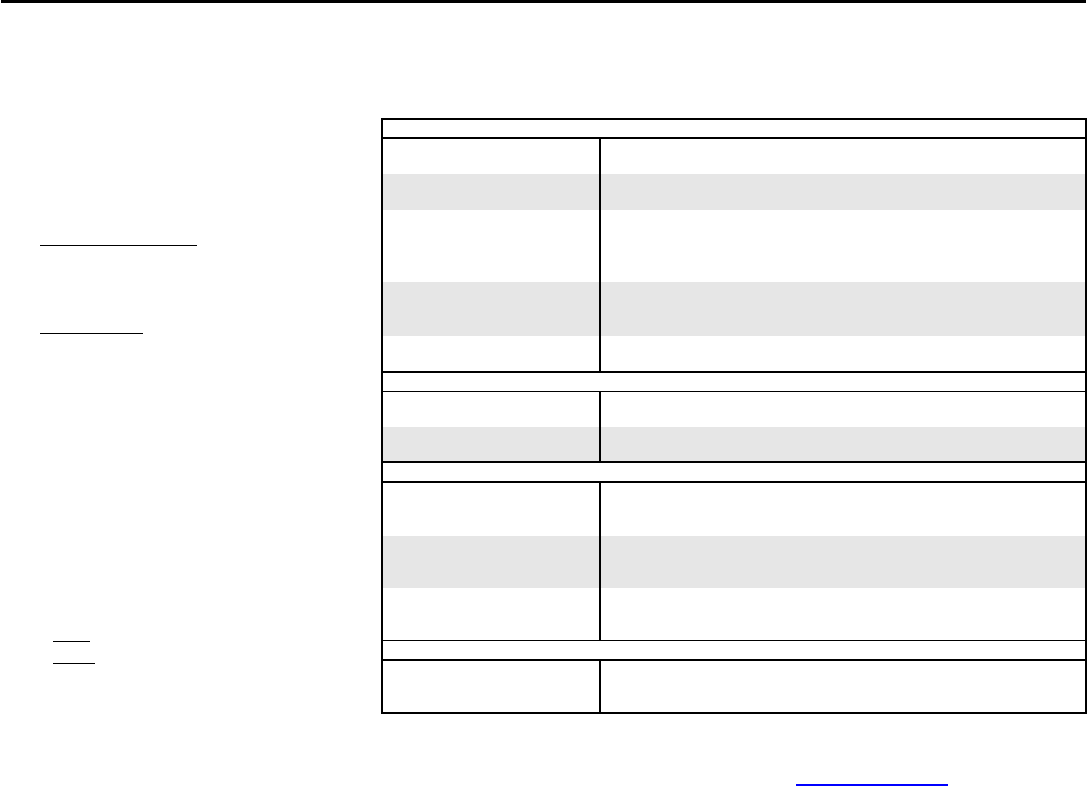
TROUBLESHOOTING
Have questions? Call 800-USA-1-USA (800-872-1872) or visit our website at www.ritron.com page 18
NOTES
1. Reception can often be improved if you relocate
by a short distance. This effect is more noticeable
inside buildings.
The range of the “Display Series” base radio is
approximately two miles, line-of-sight.
2. If your radio does not detect calls from other
radios on the channel, turn off Quiet Call by
pressing and holding both volume buttons at the
same time—a double beep indicates Quiet Call is
off.
3. Without use of a repeater: To hear a call, select a
channel programmed to receive the caller’s
transmit frequency. To call another unit, select a
channel programmed to transmit the other radio’s
receive frequency.
Using a repeater: A radio channel can hold two
separate operating frequencies, one for receive
and one for transmit. Your channel must work
with the repeater’s transmit and receive
frequencies.
NOTE: A dealer must program the radio for
repeater operation.
4. An optional RM-7 Remote Speaker / Microphone
and headset, plus the CCL-M 12 VDC Adapter,
allow operation in a vehicle. See page ii for
accessories.
5. To “talk” with each other, radios must be
programmed identically for Quiet Call code, as
well as frequency. Each code is unique; radios
respond only to the code programmed.
Press and hold both volume buttons at the same
time.
A single beep indicates Quiet Call squelch is on.
A double beep indicates Quiet Call squelch is off.
CHART
If you have trouble operating the base radio, review the Control & Operation, pages 3 through 9. If you
think the base radio is malfunctioning, check the list below.
Problem Possible Solutions
GENERAL
The radio does not work at
all.
Make sure the 120 VAC outlet is active and the RPS-1B power
supply is connected.
Operating features do not
work exactly as expected.
The radio has been dealer programmed for customized operation.
(Consult dealer.)
Reception is poor.
Move to a different location. (See Note 1.)
Confirm the proper antenna is connected to the radio.
Use an optional high-gain antenna. See page ii, Optional
Accessories.
You cannot hear calls from
other radios.
Turn off Quiet Call (coded) squelch. (See Note 2.)
Ensure radio receives the same frequency the caller transmits.
(See Note 3.)
Your calls cannot be heard in
other radios.
Make sure that your radio transmits on the receive frequency of the
radio(s) you want to call. (See Note 3.)
ERROR TONES
An error tone sounds when
the radio is first switched on.
See “Error Tones” on page 6.
An error tone occurs while
transmitting.
Refer to “Transmitter Time-Out,” page 6.
QUIET CALL
You cannot screen out calls
from users outside of your
Quiet Call group.
Make sure that the channel is programmed with Quiet Call.
Activate coded squelch. (See Note 5.)
You cannot hear Quiet Call
messages while in Quiet Call
(coded) squelch.
Confirm that the channel is programmed to detect the same code
as the calling radio(s) transmits. (See Note 5.)
Others in your Quiet Call
group cannot hear your Quiet
Call messages.
Verify that you transmit the same code as the radio(s) you call are
programmed to detect. (See Note 5.)
SCAN
The radio constantly stops on
a busy channel, preventing
you from hearing calls on.
Skip over the interfering channel when scanning. See “Temporary
Busy Channel Blocking” on page 7.

SPECIAL APPLICATION
Have questions? Call 800-USA-1-USA (800-872-1872) or visit our website at www.ritron.com page 19
HOW TO FIELD PROGRAM 2-TONE ENCODE CODES
For special applications, it is possible to use your Ritron portable radio or
base station for remote control applications; such as opening or closing a
gate remotely (see Ritron GateGuard at www.ritron.com/pdf/gg_07.pdf).
This application requires you to program the radio(s) that will be sending
the command for 2-Tone code operation, and radio(s) that will be
receiving the command (e.g. Ritron Callbox) for 2-Tone Encode
operation. The 2-Tone Codes must match.
The user can field program each channel with one of the 9 pre-set 2-
Tone Codes specified in Table 5. These codes correspond to field
programmable 2-Tone Codes available in the Ritron 6-Series or 7-Series
OUTPOST Callbox. In our example we will program a UHF radio to
operate with 2-Tone Code #94.
Important Note:
You can ADD a 2-Tone Code to a channel if the Frequency Code and Tone
Code are not changed. Changing the Frequency Code or Tone Code of a
channel will ERASE any 2-Tone Code programmed on that channel. You
must FIRST re-program the channel to the desired Frequency Code and Tone
Code and then SAVE the entry by pressing the On / Volume Up button, then
you may enter your 2-Tone Code, remember you must also SAVE this entry
by pressing the On / Volume Up button.
1. Refer to Table 5 to determine the 2 digit, 2-Tone Code(s) you wish to
program into each specific channel.
2. Follow the instructions in Fig 7, page 12 to place the radio in the
“Program / Readout Mode”.
3. Using the channel button and the LED display on the radio, select the
channel number you want to program a 2-Tone Code into.
4. Enter the 1st digit of the 2-Tone code by clicking the PTT
button until the program display shows the desired
number. Pause—the radio will sound a low tone and
show a hyphen across the display to indicate that it is
ready to accept the next digit.
5. Enter the 2nd digit of the 2-Tone code by clicking the PTT
button until the program display shows the desired
number. Pause—the radio sounds a low tone and will
show a hyphen across the display.
6. After you have entered the two digits, press and release the On /
Volume Up button to SAVE the entry. The LED display will briefly
show the channel number you have just programmed and then a
hyphen, the radio will sound a triple beep to indicate that
programming was successful.
An ERROR tone will sound if you attempt to save an incorrect code,
an “E” will appear on the LED display. Check the digits you are
attempting to program and start over.
7. You may program each channel with the same or a different 2-Tone
Code by repeating steps 3-6.
8. Turn the radio OFF and then ON again for normal operation. The “Z”
button is used to send the 2-Tone Code. See HOW TO SEND A 2-
TONE CODE below.
If more than 5 digits are displayed during readout, the radio has been
programmed for 2-Tone Encode. The frequency and tone codes will
be displayed, followed by a “C”, then the radio will display the 2-Tone
Code; see Table 5. In this example a UHF radio was programmed to
operate on the “Brown Dot” Frequency Code 04 (464.500 MHz) with
Tone Code 12 (100.0 Hz) and 2-Tone Encode Code 94.
Frequency Code Tone Code 2-Tone Code
HOW TO SEND A 2-TONE CODE
1. Select a channel that has been programmed with a 2-Tone Code.
2. Press the “Z” button to send the 2-Tone Code programmed for that
specific channel.
TABLE 5: PROGRAMMABLE 2-TONE ENCODE CODES
Code No.
Code No.
Code No.
91
94
97
92
95
98
93
96
99
Readout
Sequence
!

FCC & IC LICENSE REQUIRED
Have questions? Call 800-USA-1-USA (800-872-1872) or visit our website at www.ritron.com page 20
LICENSING
The FCC requires the owners of the radios to obtain
a station license before using them.
The station licensee is responsible for ensuring that
transmitter power, frequency and deviation are
within the limits specified by the station license. The
station licensee is also responsible for proper
operation and maintenance of the radio equipment.
This includes checking the transmitter frequency and
deviation periodically, using appropriate methods.
To get a FCC license for VHF or UHF frequencies,
submit FCC application Form 600 as indicated in the
block at right. Your Ritron dealer can help you with
this process.
SAFETY STANDARDS
The FCC (with its action in General Docket 79-144,
March 13, 1985) has adopted a safety standard for
human exposure to radio frequency electromagnetic
energy emitted by FCC regulated equipment. Ritron
observes these guidelines and recommends that
you do also:
DO NOT hold the radio so that the antenna is very
close to or touching exposed parts of the body,
especially the face or eyes, while transmitting.
Keep the radio vertical, four inches away while
talking into the front panel.
DO NOT press the Push-To-Talk except when
you intend to transmit.
DO NOT operate radio equipment near electrical
blasting caps or in an explosive atmosphere.
DO NOT allow children to play with any radio
equipment that contains a transmitting device.
Repair of Ritron products should be performed
only by Ritron authorized personnel.
HOW TO OBTAIN AN FCC RADIO LICENSE
Federal Communications Commission
(FCC) Licensing Information
Because your Ritron radio operates on Private
Land Mobile frequencies, it is subject to the
Rules and Regulations of the FCC, which
requires all operators of these frequencies to
obtain a station license before operating their
equipment. Make application for your FCC
license on FCC Forms 600 and 159.
To have forms and instructions faxed to you
by the FCC, call the FCC Fax-On-Demand
system at 202-418-0177 from your fax
machine; request Document 000600 & Form
159.
To have Document 000600 & Form 159
mailed to you, call the FCC Forms Hotline at
800-418-FORM (800-418-3676).
For help with questions concerning the
license application, contact the FCC at 888-
CALL-FCC (888-225-5322).
You must decide which radio frequency(ies)
you can operate on before filling out your
application.
For help determining your frequencies, call
Ritron at 800-USA-I-USA (800-872-1872).
INDUSTRY CANADA
REGULATIONS
Industry Canada requires the owners of the
radios to obtain a radio license before using
them. Application forms can be obtained from
the nearest Industry Canada District office.
Industry Canada License Application
1. Fill in the items per the instructions. If you
need additional space for any item, use
the reverse side of the application.
2. Use a typewriter or print legibly.
3. Make a copy for your files.
4. Prepare a check or money order to
“Receiver General for Canada”, for the
amount listed at
http://www.ic.gc.ca/eic/site/smt-
gst.nsf/eng/sf01027.html. (Licenses are
renewed annually on April 1st. Refer to
the calculation for application fees for
each month.)
5. Mail the completed application, along with
your check or money order, to the closest
Industry Canada District Office.
SERVICE
Federal law prohibits you from making any
internal adjustments to the transmitter, and /
or from changing transmit frequencies
unless you are specifically designated by the
licensee.
If your radio equipment fails to operate
properly, or you wish to have the radio
programmed, contact your local authorized
dealer or Ritron.
U.S. Manufacturer:
RITRON, INC. - Repair Department
505 West Carmel Drive,
Carmel, Indiana 46032 USA
Phone: 317-846-1201 FAX: 317-846-4978
Email: customer_service@ritron.com

RITRON, INC. LIMITED WARRANTY
Have questions? Call 800-USA-1-USA (800-872-1872) or visit our website at www.ritron.com page 21
WHAT THIS WARRANTY COVERS
RITRON, INC. (“RITRON”) provides the following warranty against defects in materials
and/or workmanship in RITRON Radios and Accessories tinder normal use and service
during the applicable warranty period (as stated below). “Accessories” means antennas,
holsters, chargers, earphones, speaker / microphones and items contained in the programming
and programming/service kits.
WHAT IS COVERED FOR HOW LONG WHAT RITRON WILL DO
“Display Series” Base 1 year * During the first year after date of
Station Radios purchase. RITRON will repair or
replace the defective product at
RITRON’s option. parts and labor
included at no charge.
Accessories 90 days * *After date of purchase
WHAT THIS WARRANTY DOES NOT COVER:
Any technical information provided with the covered product or any other RITRON
products:
Installation, maintenance or service of the product. unless this is covered by a separate
written agreement with RITRON:
Any products not furnished by RITRON which are attached or used with the covered
product. or defects or damage from the use of the covered product with equipment that is
not covered (such as defects or damage from the charging or use of batteries other than
with covered product):
Defects or damage. including broken antennas, resulting from:
- misuse, abuse, improper maintenance, alteration, modification, neglect, accident, or act
of God.
- the use of covered products other than in normal and customary manner or.
- improper testing or installation:
Defects or damages from unauthorized disassembly, repair or modification. or where
unauthorized disassembly. repair or modification prevents inspection and testing
necessary to validate warranty claims:
Defects or damages in which the serial number has been removed, altered or defaced.
Batteries if any of the seals are not intact.
WHO IS COVERED BY THIS WARRANTY
This warranty is given only to the purchaser or lessee of covered products when acquired for
use, not resale. This warranty is not assignable or transferable.
IMPORTANT
This warranty sets forth the full extent of RITRON’s express responsibilities regarding the
covered products. and is given in lieu of all other express warranties. What RITRON has
agreed to do at left is your sole and exclusive remedy. No person is authorized to make
any other warranty to you on behalf of RITRON. Warranties implied by state law, such as
implied warranties of merchantability and fitness for a particular purpose are limited to
the duration of this limited warranty as it applies to the covered product. Incidental and
consequential damages are not recoverable under this warranty (this includes loss of use
or time, inconvenience, business interruption, commercial loss, lost profits or savings).
Some states do not allow the exclusion or limitation of incidental or consequential
damages, or limitation on how long an implied warranty lasts, so the above
limitations or exclusions may not apply to you. Because each covered product system
is unique, RITRON disclaims liability for range, coverage, or operation of the system
as a whole under this warranty.
HOW TO GET WARRANTY SERVICE
To receive warranty service, you MUST deliver or send the defective product, delivery costs
and insurance prepaid, within the applicable warranty period, to RITRON. INC., 505 West
Carmel Drive, Carmel. Indiana 46032. Attention: Warranty Department.
Please point out the nature of the defect in as much detail as you can. You MUST retain
your sales or lease receipt (or other written evidence of the date of purchase) and
deliver it along with the product. If RITRON chooses to repair or replace a defective
product, RITRON may replace the product or any part or component with reconditioned
product, parts or components. Replacements are covered for the balance of the original
applicable warranty period. All replaced covered products, parts or components become
RITRON‘s property.
RIGHTS TO SOFTWARE RETAINED
Title and all rights or licenses to patents, copyrights, trademarks and trade secrets in any
RITRON software contained in covered products are and shall remain in RITRON. RITRON
nevertheless grants you a limited non-exclusive, transferable right to use the RITRON
software only in conjunction with covered products. No other license or right to the RITRON
software is granted or permitted.
YOUR RIGHTS UNDER STATE LAW
This warranty gives you specific legal rights, and you may also have other rights which vary
from state to state.
WHERE THIS WARRANTY IS VALID
This warranty is valid only within the United States, the District of Columbia and Puerto Rico.
505 West Carmel Drive • Carmel, IN 46032
P.0. Box 1998 • Carmel, IN 46082-1998
Ph: 317-846-1201 • Fax: 317-846-4978 • Email: ritron@ritron.com
Website: www.ritron.com
Pub 14500087 REV. A 10-14
© 1999-2014 RITRON, INC. • ALL RIGHTS RESERVED
RITRON, JOBCOM, QUICK ASSIST, OUTPOST, GATEGUARD,
RADIONEXUS and QUIET CALLARE REGISTERED TRADEMARKS OF RITRON, INC.
QUICK TALK AND LIBERTY ARE TRADEMARKS OF RITRON. INC.

ADDENDUM TO MANUAL
Have questions? Call 800-USA-1-USA (800-872-1872) or visit our website at www.ritron.com page 22
JBS-146i-A and JBS-446D-A Instructions
Auto Turn On When Power Restored
Ritron models JBS-146i-A and JBS-446D-A have been built to operate any time power is applied to the base radio, eliminating the need
to press the On/Volume Up button to turn the radio on.
The JBS-146i-A and JBS-446D-A model base radios ............................................................................................................................
• Will turn on any time power is applied to the radio, allowing it to automatically turn back on after a power failure.
• Will store the current channel in EEPROM each time the channel is changed, assuring that the radio will automatically restart
to the current operating channel after a power outage. As an alternative, the radio can be PC programmed to turn on to
channel 1 whenever power is applied.
• Will not turn-off by pressing the Volume Down/Off button. The only way to turn the radio off is to remove power.
• Will restart to a mid volume level after a power outage. As an alternative, this option can be disabled using the PC
Programmer and the radio will turn on at minimum volume.
• Will not turn-off as a result of a low battery condition, therefore, the JBS-146i-A is not recommended for battery powered
applications.
• Does not have Power Save capability for battery conservation.
• Requires Ritron PC Programmer 9.6.0 or higher.
To place the JBS-146i-A or JBS-446D-A into field programming mode ..............................................................................................
1. Remove power from the JBS-146i-A or JBS-446D-A base radio.
2. Hold down the PTT button and re-apply power.
3. Continue to hold the PTT until the beeping has stopped, then release.
4. The radio will display a series of six characters for Radio Identification, then a triple beep will be heard indicating that the JBS-
146i-A or JBS-446D-A base radio is in program mode.
5. When programming is complete, remove power and re-apply to return the radio to normal operating mode.